For many dog lovers, the joy of pet ownership comes with a common challenge: shedding. Dog hair can accumulate quickly, trigger allergies, and require constant cleaning. This is why dog breeds that don’t shed much have become incredibly appealing to a wide range of individuals and families. Whether you’re seeking a cleaner home, have mild allergies, or simply prefer a low-maintenance coat, understanding which dog breed that doesn’t shed much might be the perfect fit for your lifestyle is key. While no dog is entirely free of shedding, some breeds produce significantly less loose hair and dander, making them excellent choices for those seeking a tidy companion.
Understanding Low Shedding: What Makes a Dog “Hypoallergenic”?
The term “hypoallergenic” is often used to describe dogs that don’t shed much, but it’s important to understand what this truly means. All dogs produce allergens, primarily from proteins found in their skin (dander), saliva, and urine, not just their hair. However, dogs that shed less release fewer of these allergens into the environment because their dander-laden hair isn’t constantly falling out. This reduction in airborne allergens is what makes them a better fit for some people with sensitivities.
It’s crucial to remember that no dog is 100% allergen-free. Even breeds recognized for their low-shedding qualities still have skin, saliva, and urine, which contain proteins that can trigger allergic reactions such as coughing, itching, or wheezing. The benefit of a low-shedding dog is the reduced dispersal of these allergens. For individuals with severe allergies, a low-shedding breed can still cause a reaction, so interacting with the specific breed beforehand is always recommended.
Top Dog Breeds That Don’t Shed Much
While completely non-shedding dogs don’t exist, many breeds have coats that shed minimally, trapping loose hair and dander rather than releasing it into your home. This makes them ideal for various living situations, from apartments to larger homes, and for owners looking to minimize cleanup. Here are some of the best low-shedding dog breeds known for their minimal hair loss:
1. Poodle
 A majestic white Poodle with its signature curly, low-shedding coat confidently walking through green grass on a sunny day.Poodles are perhaps the most famous low-shedding dog breed, celebrated for their elegance and intelligence. Available in three sizes—Standard, Miniature, and Toy—there’s a Poodle for almost every living arrangement. Their dense, curly coat sheds very little, making them a top choice for those concerned about loose hair and dander. Despite their minimal shedding, Poodles require consistent grooming to prevent their curls from matting. Regular brushing (ideally daily) and professional clipping every 4-6 weeks are essential to maintain their coat’s health and pristine appearance. Beyond their low-shedding attribute, Poodles are highly intelligent and trainable, excelling in obedience and various dog sports.
A majestic white Poodle with its signature curly, low-shedding coat confidently walking through green grass on a sunny day.Poodles are perhaps the most famous low-shedding dog breed, celebrated for their elegance and intelligence. Available in three sizes—Standard, Miniature, and Toy—there’s a Poodle for almost every living arrangement. Their dense, curly coat sheds very little, making them a top choice for those concerned about loose hair and dander. Despite their minimal shedding, Poodles require consistent grooming to prevent their curls from matting. Regular brushing (ideally daily) and professional clipping every 4-6 weeks are essential to maintain their coat’s health and pristine appearance. Beyond their low-shedding attribute, Poodles are highly intelligent and trainable, excelling in obedience and various dog sports.
2. Yorkshire Terrier
 A charming blue and tan Yorkshire Terrier, a popular low-shedding breed, lounging comfortably on a plush armchair.These petite dogs may have long, silky hair, but Yorkshire Terriers are renowned for their low-shedding coats. Their fine, human-like hair sheds much less than many other breeds, making them a popular choice among those seeking a dog breed that doesn’t shed much. Yorkies are known for their spirited personalities, affectionate nature, and adaptability. They can thrive in various environments, from spacious houses to compact apartments, as long as they receive ample attention and mental stimulation from their families. Daily brushing is crucial to prevent tangles and mats in their long coats, though many owners opt for a shorter “puppy cut” for easier maintenance.
A charming blue and tan Yorkshire Terrier, a popular low-shedding breed, lounging comfortably on a plush armchair.These petite dogs may have long, silky hair, but Yorkshire Terriers are renowned for their low-shedding coats. Their fine, human-like hair sheds much less than many other breeds, making them a popular choice among those seeking a dog breed that doesn’t shed much. Yorkies are known for their spirited personalities, affectionate nature, and adaptability. They can thrive in various environments, from spacious houses to compact apartments, as long as they receive ample attention and mental stimulation from their families. Daily brushing is crucial to prevent tangles and mats in their long coats, though many owners opt for a shorter “puppy cut” for easier maintenance.
3. Shih Tzu
 A lovable brown and white Shih Tzu, a small non-shedding dog, relaxing on a living room floor, showcasing its long, flowing coat.The Shih Tzu, an ancient companion breed originating from Tibetan nobility, boasts a thick, double coat that sheds minimally. While their long, flowing hair requires dedicated grooming to prevent matting, the amount of loose hair they drop is surprisingly low, placing them firmly on the list of dogs that don’t shed much. These friendly and outgoing dogs are known for their charming personalities and gentle demeanor, making them wonderful family pets. However, their distinctive flat faces can predispose them to certain health concerns, including overheating and breathing difficulties, especially in warm weather. Regular eye cleaning can also help manage tear stains, a common issue for the breed.
A lovable brown and white Shih Tzu, a small non-shedding dog, relaxing on a living room floor, showcasing its long, flowing coat.The Shih Tzu, an ancient companion breed originating from Tibetan nobility, boasts a thick, double coat that sheds minimally. While their long, flowing hair requires dedicated grooming to prevent matting, the amount of loose hair they drop is surprisingly low, placing them firmly on the list of dogs that don’t shed much. These friendly and outgoing dogs are known for their charming personalities and gentle demeanor, making them wonderful family pets. However, their distinctive flat faces can predispose them to certain health concerns, including overheating and breathing difficulties, especially in warm weather. Regular eye cleaning can also help manage tear stains, a common issue for the breed.
4. Miniature Schnauzer
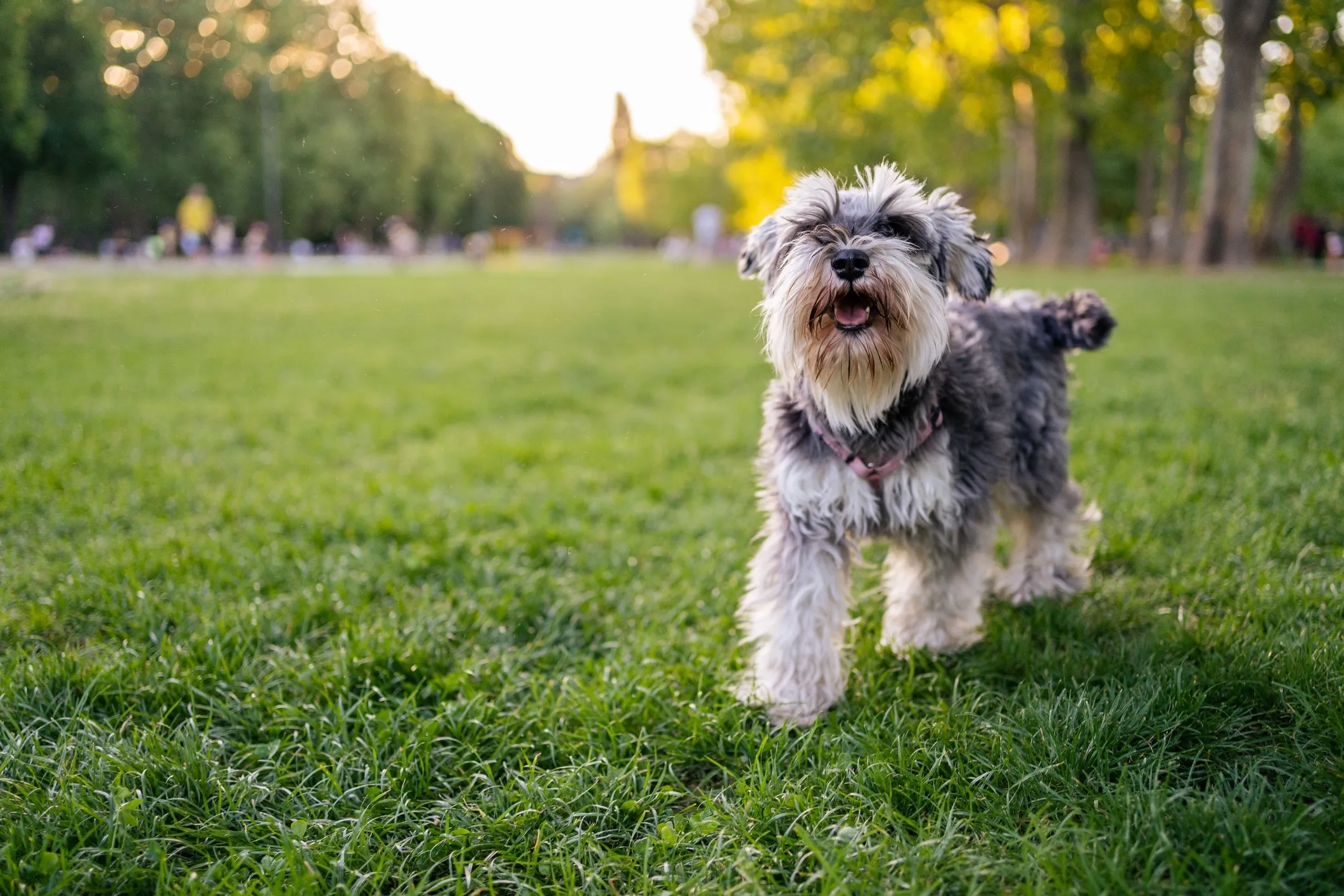 A distinctive salt and pepper Miniature Schnauzer wearing a pink harness, standing alertly in a vibrant park setting.The Miniature Schnauzer is the smallest of the three Schnauzer breeds and an excellent example of a small well behaved dogs that don’t shed. Their wiry, dense double coat sheds very little, making them an ideal choice for those looking to minimize dog hair around the home. Weighing between 10 to 20 pounds and standing no more than 14 inches tall, these intelligent and sturdy dogs are highly adaptable to various living situations, including urban apartments. They are energetic and require at least an hour of exercise daily to stay happy and well-behaved. Their distinctive beard and eyebrows also require regular trimming or hand-stripping to keep their coat in top condition.
A distinctive salt and pepper Miniature Schnauzer wearing a pink harness, standing alertly in a vibrant park setting.The Miniature Schnauzer is the smallest of the three Schnauzer breeds and an excellent example of a small well behaved dogs that don’t shed. Their wiry, dense double coat sheds very little, making them an ideal choice for those looking to minimize dog hair around the home. Weighing between 10 to 20 pounds and standing no more than 14 inches tall, these intelligent and sturdy dogs are highly adaptable to various living situations, including urban apartments. They are energetic and require at least an hour of exercise daily to stay happy and well-behaved. Their distinctive beard and eyebrows also require regular trimming or hand-stripping to keep their coat in top condition.
5. Standard Schnauzer
 A graceful gray Standard Schnauzer standing proudly in a lush green field, highlighting its strong physique and distinctive coat.The Standard Schnauzer shares many desirable traits with its miniature counterpart, including a low-shedding, wiry coat, but comes in a slightly larger package. These medium-sized dogs can weigh up to 45 pounds and possess a robust build. Like all Schnauzers, their minimal shedding makes them a favored choice for those sensitive to pet dander. Standard Schnauzers are highly intelligent, energetic, and thrive on regular physical activity and mental stimulation. They love engaging in long walks, games of fetch, and solving puzzle toys, which keeps their keen minds engaged and their bodies fit.
A graceful gray Standard Schnauzer standing proudly in a lush green field, highlighting its strong physique and distinctive coat.The Standard Schnauzer shares many desirable traits with its miniature counterpart, including a low-shedding, wiry coat, but comes in a slightly larger package. These medium-sized dogs can weigh up to 45 pounds and possess a robust build. Like all Schnauzers, their minimal shedding makes them a favored choice for those sensitive to pet dander. Standard Schnauzers are highly intelligent, energetic, and thrive on regular physical activity and mental stimulation. They love engaging in long walks, games of fetch, and solving puzzle toys, which keeps their keen minds engaged and their bodies fit.
6. Giant Schnauzer
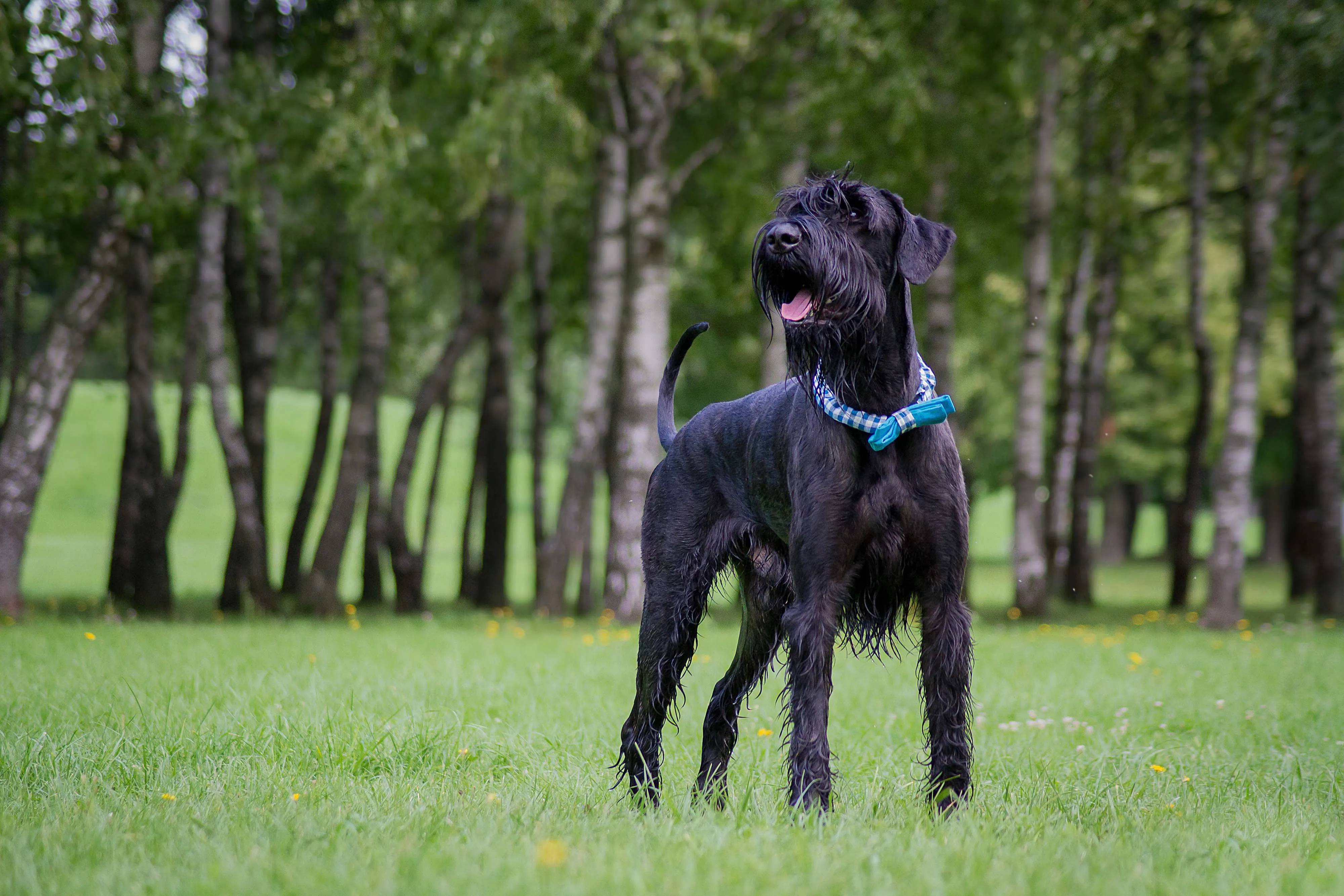 A striking black, wet Giant Schnauzer wearing a blue bow collar, standing majestically in a park after a playful session.As their name suggests, Giant Schnauzers are the largest of the Schnauzer family, capable of reaching over 27 inches in height and weighing up to 85 pounds. Despite their imposing size, their coarse, dense coat sheds very little, cementing their place among dogs that don’t shed and don’t need grooming (though they do need regular grooming, just not heavy shedding). These intelligent and powerful dogs demand a significant amount of exercise to stay content and well-adjusted. Activities like long walks, vigorous runs, challenging hikes, and extensive games of fetch are crucial for tiring out their boundless energy. Their loyalty and protective nature make them excellent guardians and devoted family members when properly trained and socialized.
A striking black, wet Giant Schnauzer wearing a blue bow collar, standing majestically in a park after a playful session.As their name suggests, Giant Schnauzers are the largest of the Schnauzer family, capable of reaching over 27 inches in height and weighing up to 85 pounds. Despite their imposing size, their coarse, dense coat sheds very little, cementing their place among dogs that don’t shed and don’t need grooming (though they do need regular grooming, just not heavy shedding). These intelligent and powerful dogs demand a significant amount of exercise to stay content and well-adjusted. Activities like long walks, vigorous runs, challenging hikes, and extensive games of fetch are crucial for tiring out their boundless energy. Their loyalty and protective nature make them excellent guardians and devoted family members when properly trained and socialized.
7. Bichon Frise
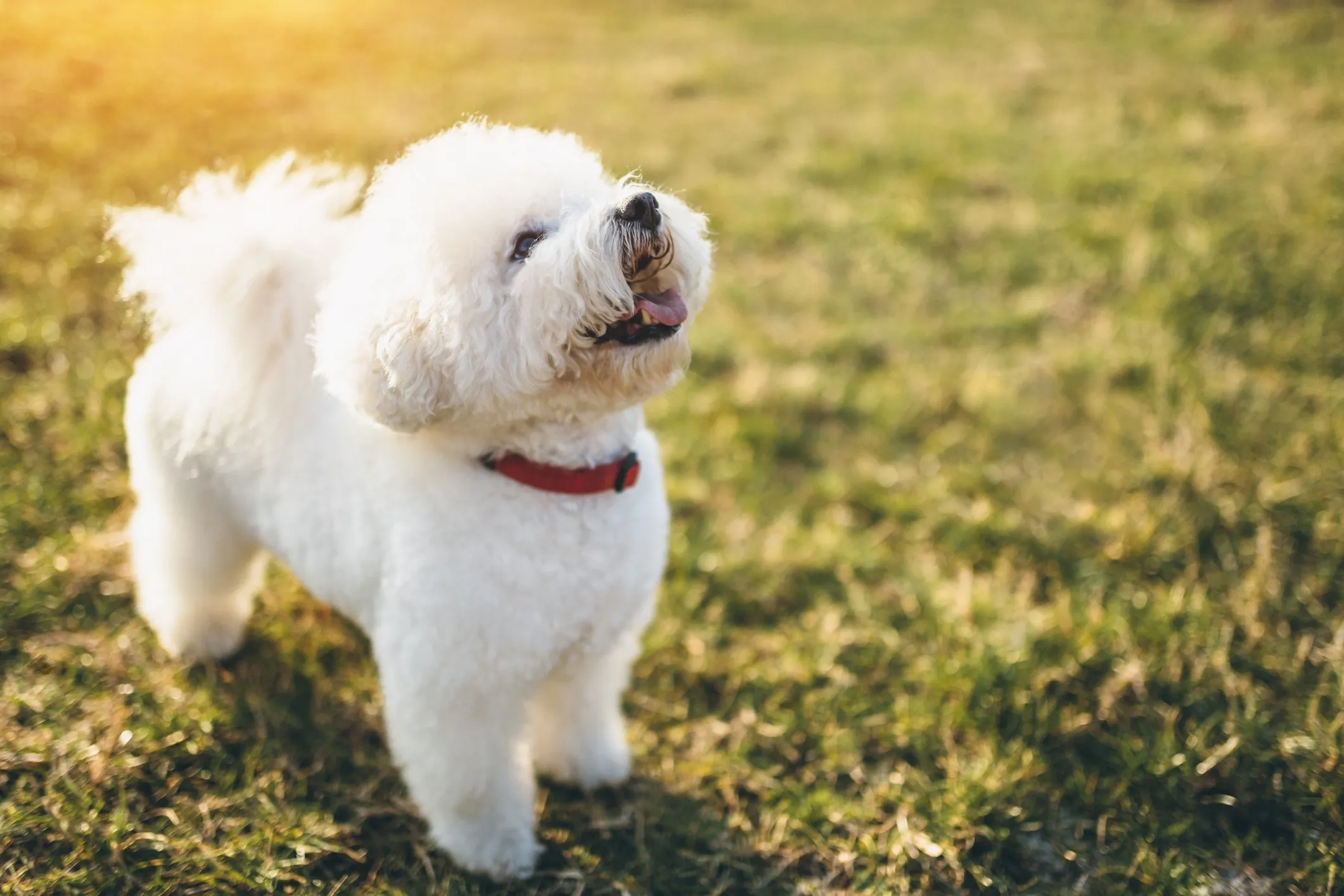 A charming white Bichon Frise with its fluffy, curly, low-shedding coat looking up inquisitively in a vibrant green grassy area.The Bichon Frise is a cheerful, playful, and affectionate small dog with a distinct powder-puff, curly coat that sheds minimally. This non-shedding characteristic makes them a favorite for many seeking a cleaner home environment. Bichons are highly intelligent and remarkably trainable, often quickly mastering basic commands and delighting their families with impressive tricks. They respond exceptionally well to positive reinforcement, thriving on praise and treats. Their lively yet gentle nature makes them excellent companions for families, adapting well to various living situations as long as they receive plenty of love and attention. Regular grooming is essential to keep their soft, fluffy coat from matting.
A charming white Bichon Frise with its fluffy, curly, low-shedding coat looking up inquisitively in a vibrant green grassy area.The Bichon Frise is a cheerful, playful, and affectionate small dog with a distinct powder-puff, curly coat that sheds minimally. This non-shedding characteristic makes them a favorite for many seeking a cleaner home environment. Bichons are highly intelligent and remarkably trainable, often quickly mastering basic commands and delighting their families with impressive tricks. They respond exceptionally well to positive reinforcement, thriving on praise and treats. Their lively yet gentle nature makes them excellent companions for families, adapting well to various living situations as long as they receive plenty of love and attention. Regular grooming is essential to keep their soft, fluffy coat from matting.
8. Chinese Crested
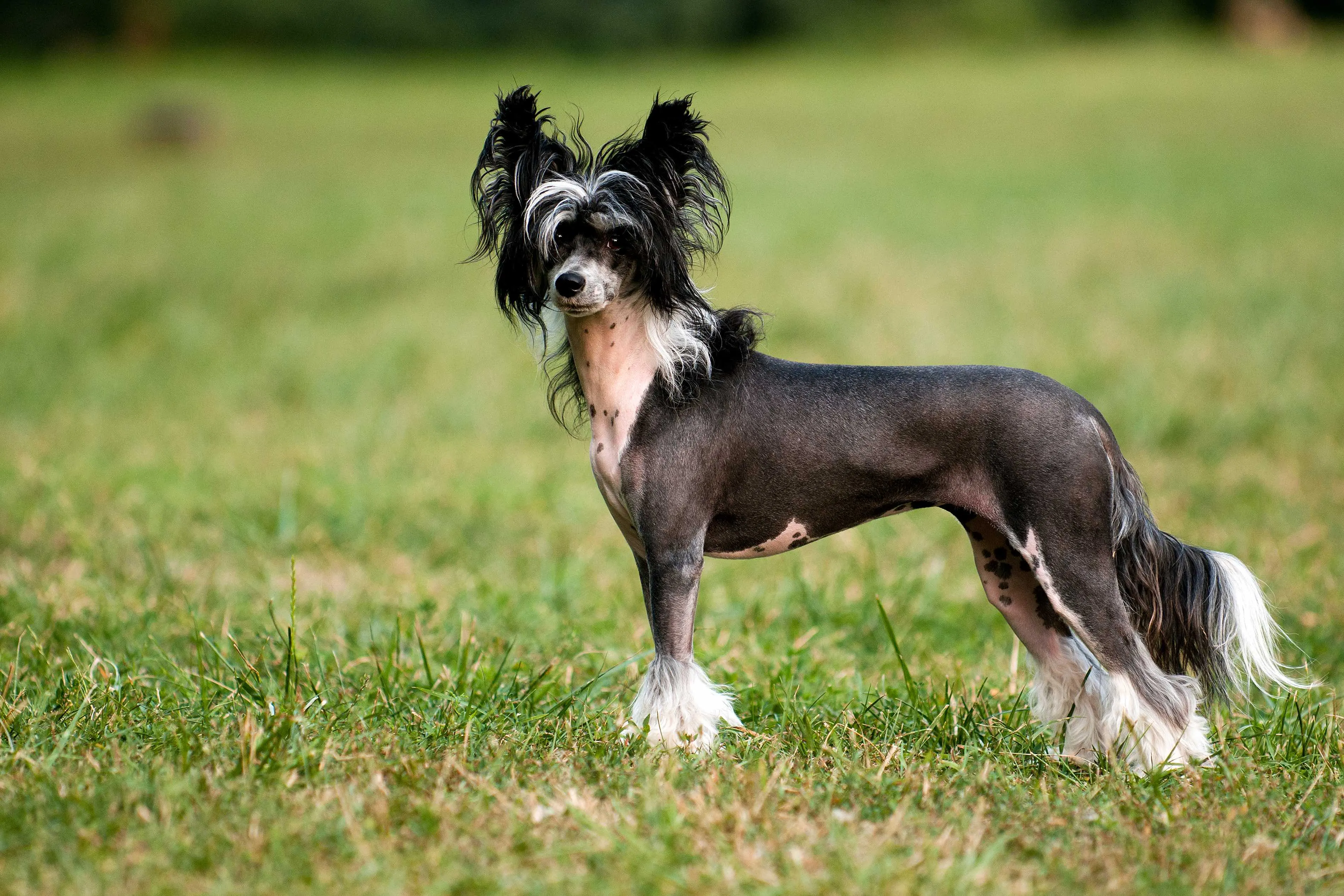 A unique black hairless Chinese Crested dog attentively gazing at the camera, showcasing its distinctive appearance.The Chinese Crested is a small breed recognized for its truly unique appearance, and notably, its low-shedding quality. There are two varieties: the Hairless, which has smooth, soft skin with tufts of hair on its head, tail, and paws; and the Powderpuff, which is covered in a long, silky coat. Both varieties are considered to be excellent choices for those looking for a dog breed that doesn’t shed much. These dogs are playful, affectionate, and make wonderful companions, forming strong bonds with their owners. The Hairless variety requires skin care to prevent sunburn and dryness, while the Powderpuff’s coat needs regular brushing to prevent tangles.
A unique black hairless Chinese Crested dog attentively gazing at the camera, showcasing its distinctive appearance.The Chinese Crested is a small breed recognized for its truly unique appearance, and notably, its low-shedding quality. There are two varieties: the Hairless, which has smooth, soft skin with tufts of hair on its head, tail, and paws; and the Powderpuff, which is covered in a long, silky coat. Both varieties are considered to be excellent choices for those looking for a dog breed that doesn’t shed much. These dogs are playful, affectionate, and make wonderful companions, forming strong bonds with their owners. The Hairless variety requires skin care to prevent sunburn and dryness, while the Powderpuff’s coat needs regular brushing to prevent tangles.
9. Portuguese Water Dog
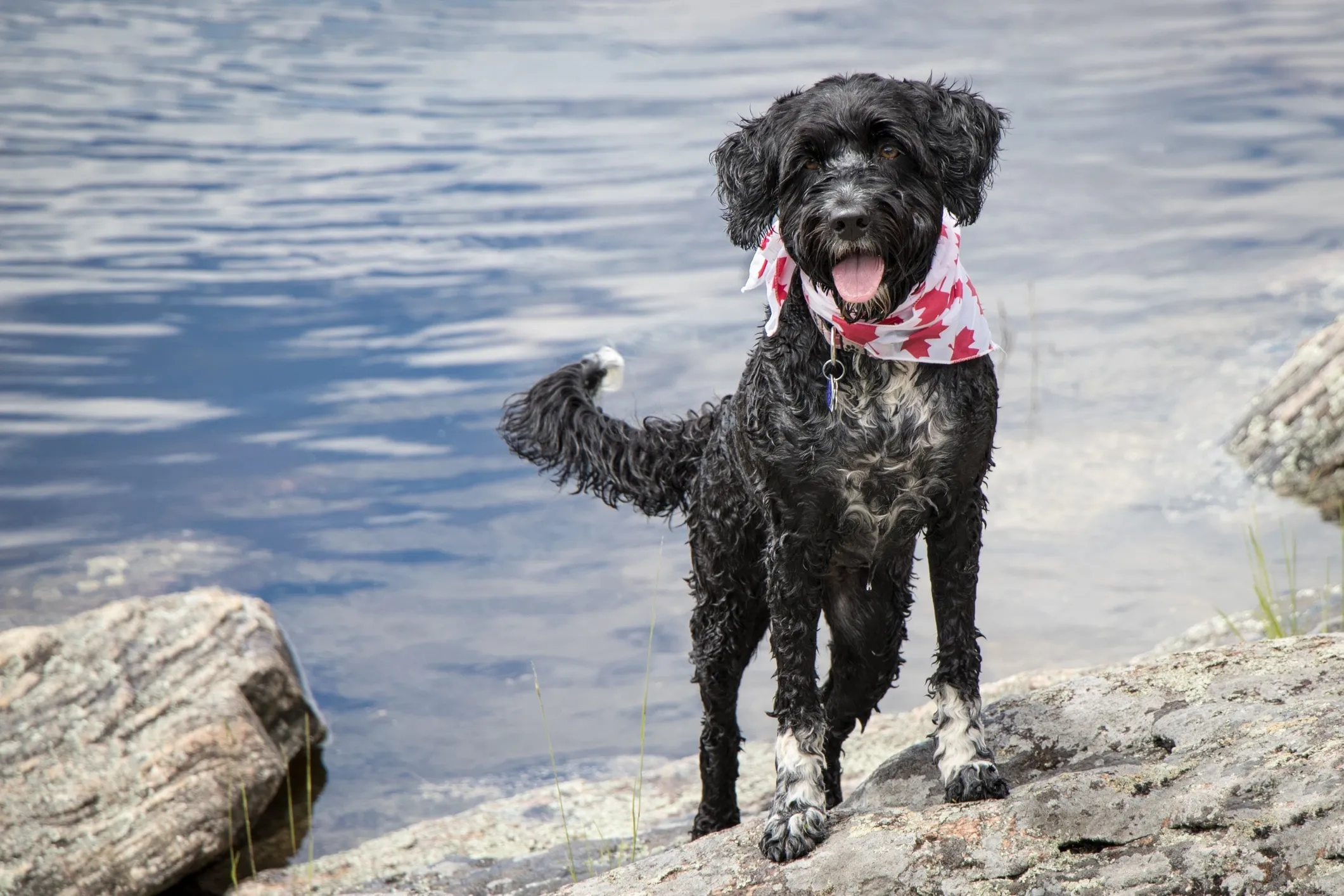 A black and white Portuguese Water Dog, a medium-sized low-shedding breed, wearing a red maple leaf bandana by the water.Originally bred to assist fishermen in Portugal, the Portuguese Water Dog is a robust, medium-sized breed with a thick, curly, and water-resistant coat that sheds very little. This characteristic makes them a popular choice for individuals concerned about shedding. PWDs are known for their intelligence, high trainability, and friendly disposition, making them versatile and engaging family members. They are high-energy pups who thrive on regular, vigorous exercise, especially activities involving water, which they inherently love. Swimming, long walks, and mentally stimulating games are key to keeping these dogs happy and healthy. Their curly coats require consistent grooming to prevent matting.
A black and white Portuguese Water Dog, a medium-sized low-shedding breed, wearing a red maple leaf bandana by the water.Originally bred to assist fishermen in Portugal, the Portuguese Water Dog is a robust, medium-sized breed with a thick, curly, and water-resistant coat that sheds very little. This characteristic makes them a popular choice for individuals concerned about shedding. PWDs are known for their intelligence, high trainability, and friendly disposition, making them versatile and engaging family members. They are high-energy pups who thrive on regular, vigorous exercise, especially activities involving water, which they inherently love. Swimming, long walks, and mentally stimulating games are key to keeping these dogs happy and healthy. Their curly coats require consistent grooming to prevent matting.
10. Labradoodle
 A friendly brown Standard Labradoodle, a popular low-shedding hybrid, enjoying a walk in a sunny park.The Labradoodle is a charming crossbreed resulting from the pairing of a Labrador Retriever and a Poodle. Originally developed to be a service dog for people with allergies, many Labradoodles inherit the Poodle’s low-shedding coat, making them an excellent dog breed that doesn’t shed much. They are known for their intelligence, friendly nature, and gentle demeanor, qualities that make them superb family pets. Labradoodles are highly trainable and generally gentle, especially when they receive sufficient exercise and are well-socialized from a young age. Their coats can vary in texture (fleece, wool, or hair) and require regular grooming to prevent matting, especially the wool and fleece types.
A friendly brown Standard Labradoodle, a popular low-shedding hybrid, enjoying a walk in a sunny park.The Labradoodle is a charming crossbreed resulting from the pairing of a Labrador Retriever and a Poodle. Originally developed to be a service dog for people with allergies, many Labradoodles inherit the Poodle’s low-shedding coat, making them an excellent dog breed that doesn’t shed much. They are known for their intelligence, friendly nature, and gentle demeanor, qualities that make them superb family pets. Labradoodles are highly trainable and generally gentle, especially when they receive sufficient exercise and are well-socialized from a young age. Their coats can vary in texture (fleece, wool, or hair) and require regular grooming to prevent matting, especially the wool and fleece types.
11. Goldendoodle
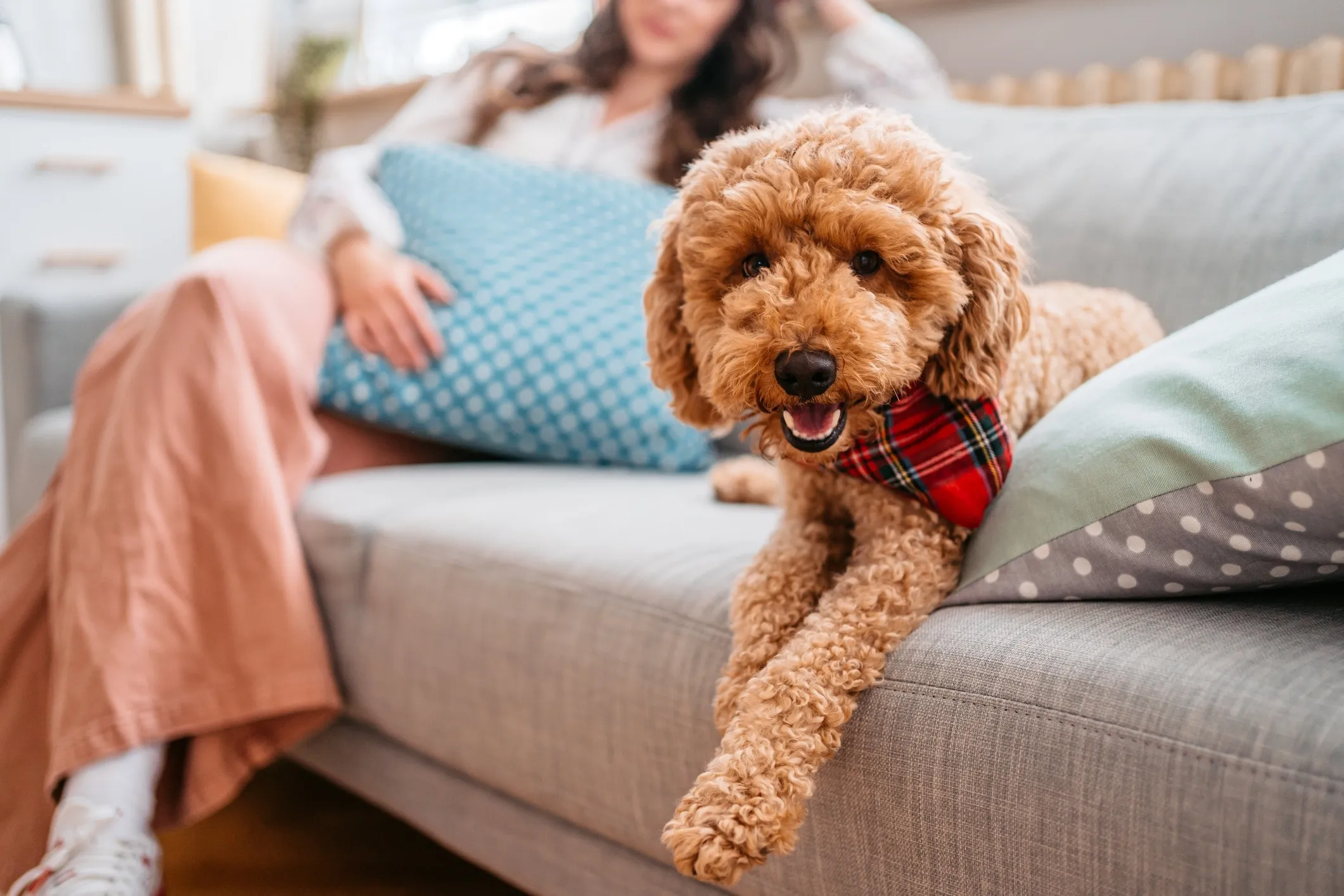 A beautiful Goldendoodle lying comfortably on a couch with a person in the background, showing its soft, low-shedding coat.Goldendoodles are another highly popular “doodle” breed, a cross between a Golden Retriever and a Poodle. Much like the Labradoodle, these dogs are highly sought after for their low-shedding coats, which are typically inherited from their Poodle parent. They combine the Golden Retriever’s friendly, affectionate nature with the Poodle’s intelligence, resulting in a dog that is both loving and smart. While many Goldendoodles are famous for their golden coats, they can come in a wide array of colors and coat textures. Regardless of color, their coats demand frequent grooming, often with a slicker brush, to prevent tangles and matting and maintain their plush appearance.
A beautiful Goldendoodle lying comfortably on a couch with a person in the background, showing its soft, low-shedding coat.Goldendoodles are another highly popular “doodle” breed, a cross between a Golden Retriever and a Poodle. Much like the Labradoodle, these dogs are highly sought after for their low-shedding coats, which are typically inherited from their Poodle parent. They combine the Golden Retriever’s friendly, affectionate nature with the Poodle’s intelligence, resulting in a dog that is both loving and smart. While many Goldendoodles are famous for their golden coats, they can come in a wide array of colors and coat textures. Regardless of color, their coats demand frequent grooming, often with a slicker brush, to prevent tangles and matting and maintain their plush appearance.
12. Lagotto Romagnolo
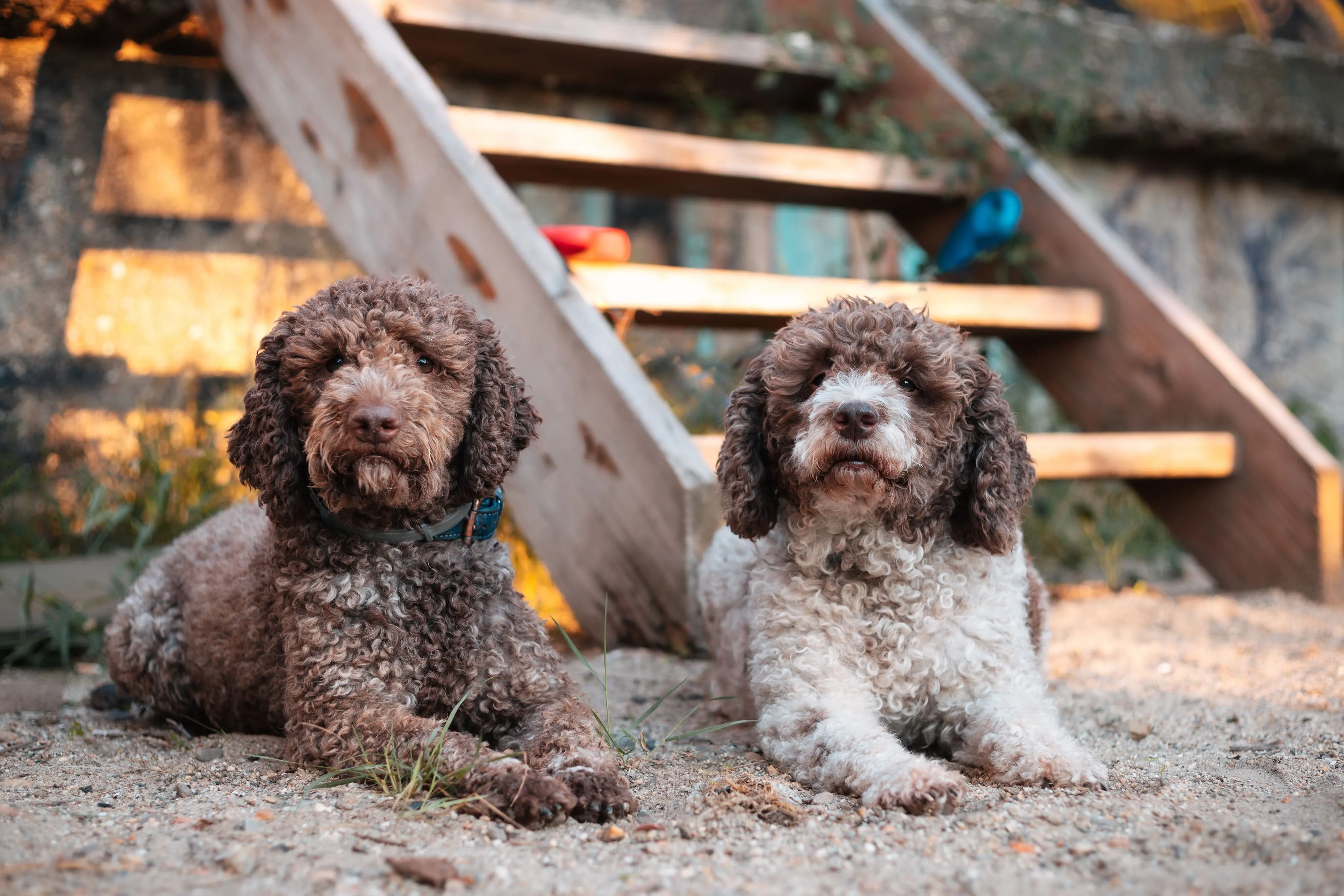 Two expressive Lagotto Romagnolo dogs, known for their curly, low-shedding coats, lying in the dirt and looking at the camera.The Lagotto Romagnolo, an ancient Italian breed, was originally bred as a water retriever. Their distinctive curly, woolly coat is not only functional, protecting them from cold waters, but also sheds minimally, making them a good choice for those looking for a dog breed that doesn’t shed much. Although less common than some other low-shedding breeds, Lagotti Romagnoli (the proper plural) are known for being good with children and other pets, making them wonderful family dogs. They are intelligent and eager to please, thriving on mental and physical activities. Their coats require regular clipping and brushing to prevent felting and maintain their characteristic appearance.
Two expressive Lagotto Romagnolo dogs, known for their curly, low-shedding coats, lying in the dirt and looking at the camera.The Lagotto Romagnolo, an ancient Italian breed, was originally bred as a water retriever. Their distinctive curly, woolly coat is not only functional, protecting them from cold waters, but also sheds minimally, making them a good choice for those looking for a dog breed that doesn’t shed much. Although less common than some other low-shedding breeds, Lagotti Romagnoli (the proper plural) are known for being good with children and other pets, making them wonderful family dogs. They are intelligent and eager to please, thriving on mental and physical activities. Their coats require regular clipping and brushing to prevent felting and maintain their characteristic appearance.
13. Affenpinscher
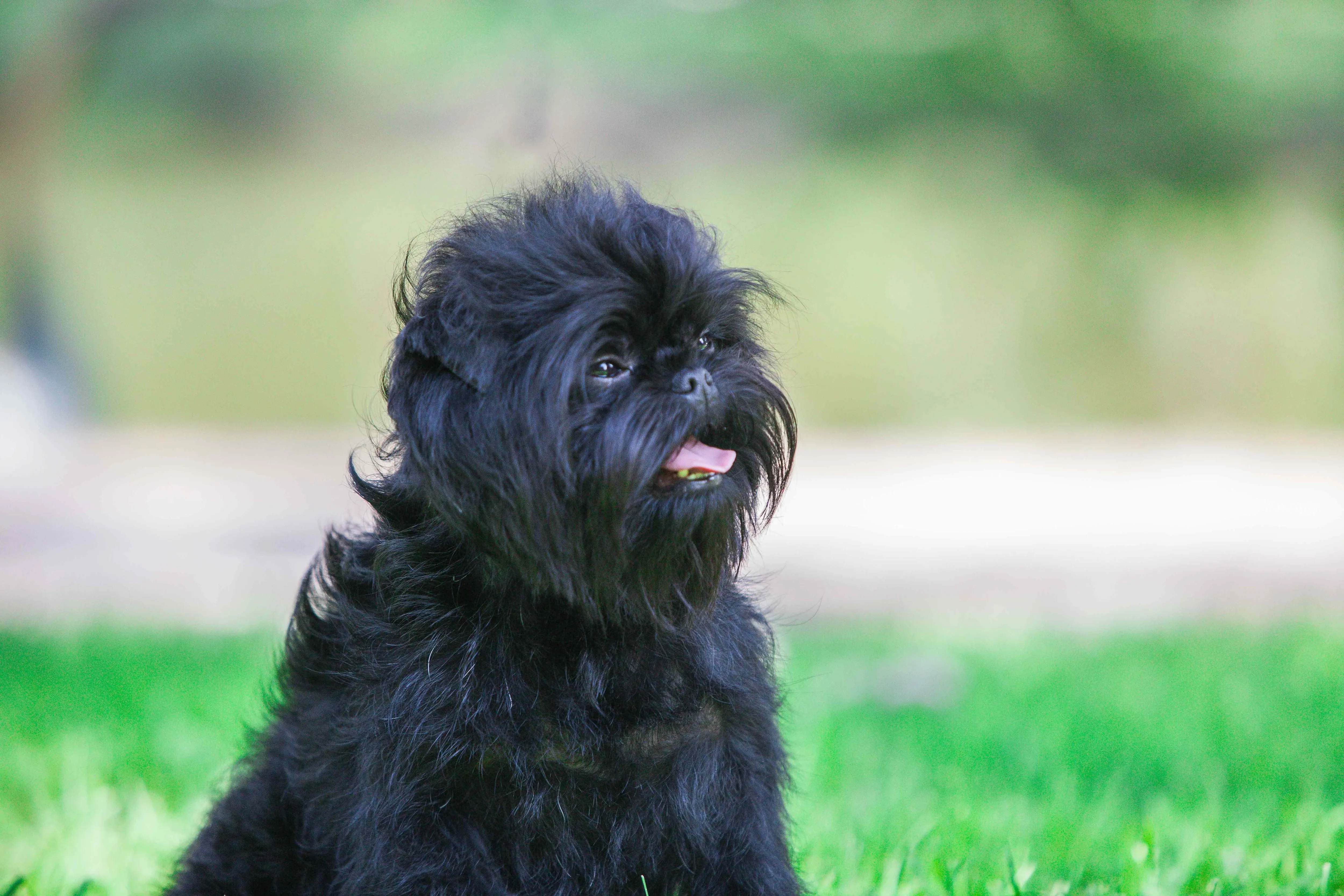 A close-up of a dark-furred Affenpinscher dog, highlighting its unique monkey-like face and wiry, low-shedding coat.Affenpinschers are small dogs often described as having a “monkey-like” appearance, and they are excellent examples of a dog breed that doesn’t shed much. Their dense, wiry coat, while requiring regular care, produces fewer allergens than many other dog breeds. This unique coat needs more than just simple brushing; it often requires hand-stripping, a traditional grooming method where dead hair is plucked from the root instead of trimmed. Affenpinschers are known for their confident, curious, and sometimes mischievous personalities. They are affectionate with their families but can be quite independent, bringing a lot of character into a home.
A close-up of a dark-furred Affenpinscher dog, highlighting its unique monkey-like face and wiry, low-shedding coat.Affenpinschers are small dogs often described as having a “monkey-like” appearance, and they are excellent examples of a dog breed that doesn’t shed much. Their dense, wiry coat, while requiring regular care, produces fewer allergens than many other dog breeds. This unique coat needs more than just simple brushing; it often requires hand-stripping, a traditional grooming method where dead hair is plucked from the root instead of trimmed. Affenpinschers are known for their confident, curious, and sometimes mischievous personalities. They are affectionate with their families but can be quite independent, bringing a lot of character into a home.
14. Irish Water Spaniel
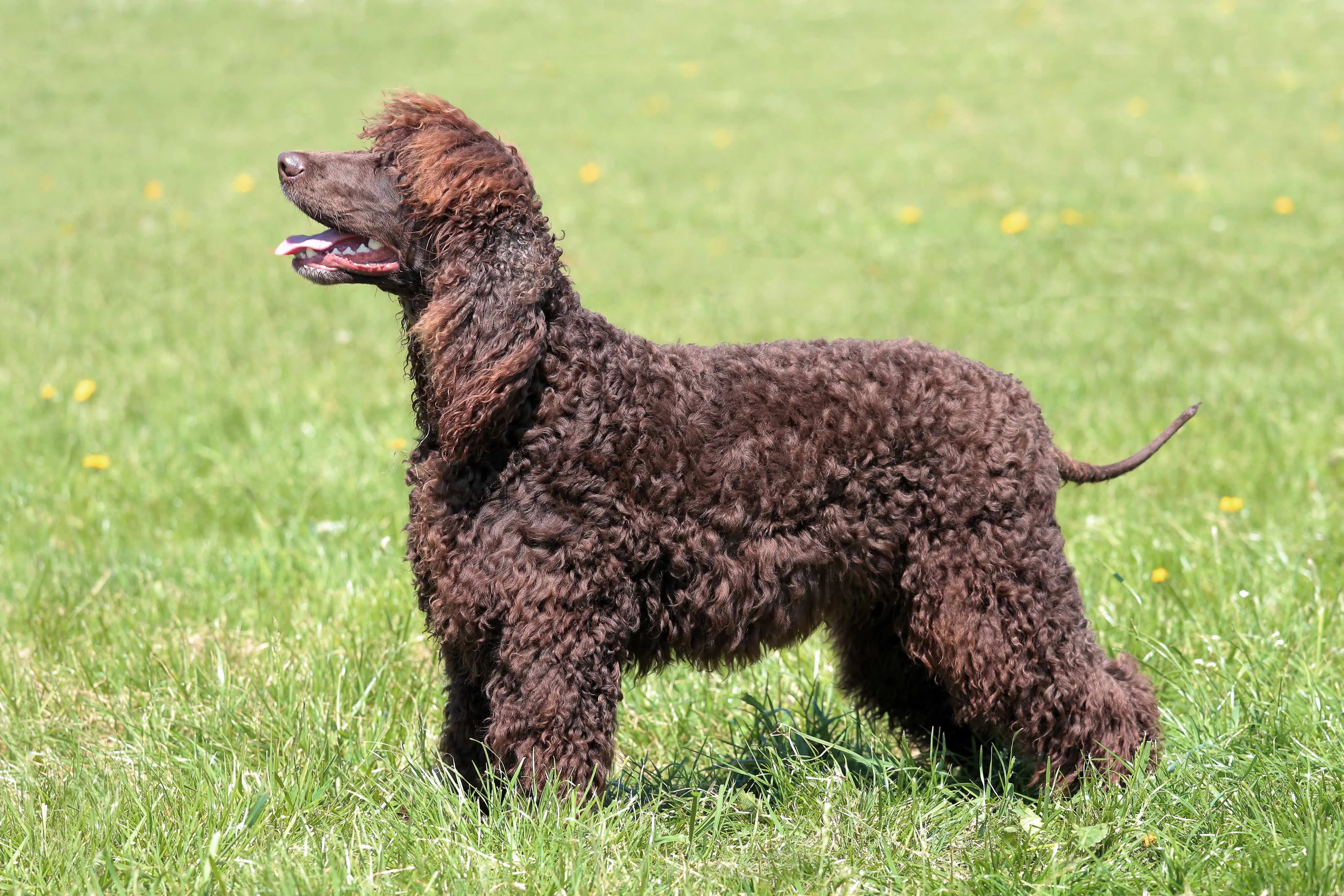 A profile shot of a brown Irish Water Spaniel, a strong, intelligent, and low-shedding water dog breed.Friendly, highly intelligent, and remarkably trainable, the Irish Water Spaniel is another distinguished water dog breed originally developed for retrieving game. Their thick, tightly curled coat is naturally water-repellent and sheds very little, making them a fantastic option for those seeking a dog breed that doesn’t shed much. This breed’s coat is always a rich liver (brown) color and requires regular grooming to keep it in optimal condition and prevent matting. With a high energy level, Irish Water Spaniels need consistent and vigorous exercise to remain happy and healthy. They excel in activities like swimming, retrieving, and agility, showcasing their athleticism and keen minds.
A profile shot of a brown Irish Water Spaniel, a strong, intelligent, and low-shedding water dog breed.Friendly, highly intelligent, and remarkably trainable, the Irish Water Spaniel is another distinguished water dog breed originally developed for retrieving game. Their thick, tightly curled coat is naturally water-repellent and sheds very little, making them a fantastic option for those seeking a dog breed that doesn’t shed much. This breed’s coat is always a rich liver (brown) color and requires regular grooming to keep it in optimal condition and prevent matting. With a high energy level, Irish Water Spaniels need consistent and vigorous exercise to remain happy and healthy. They excel in activities like swimming, retrieving, and agility, showcasing their athleticism and keen minds.
15. Aussiedoodle
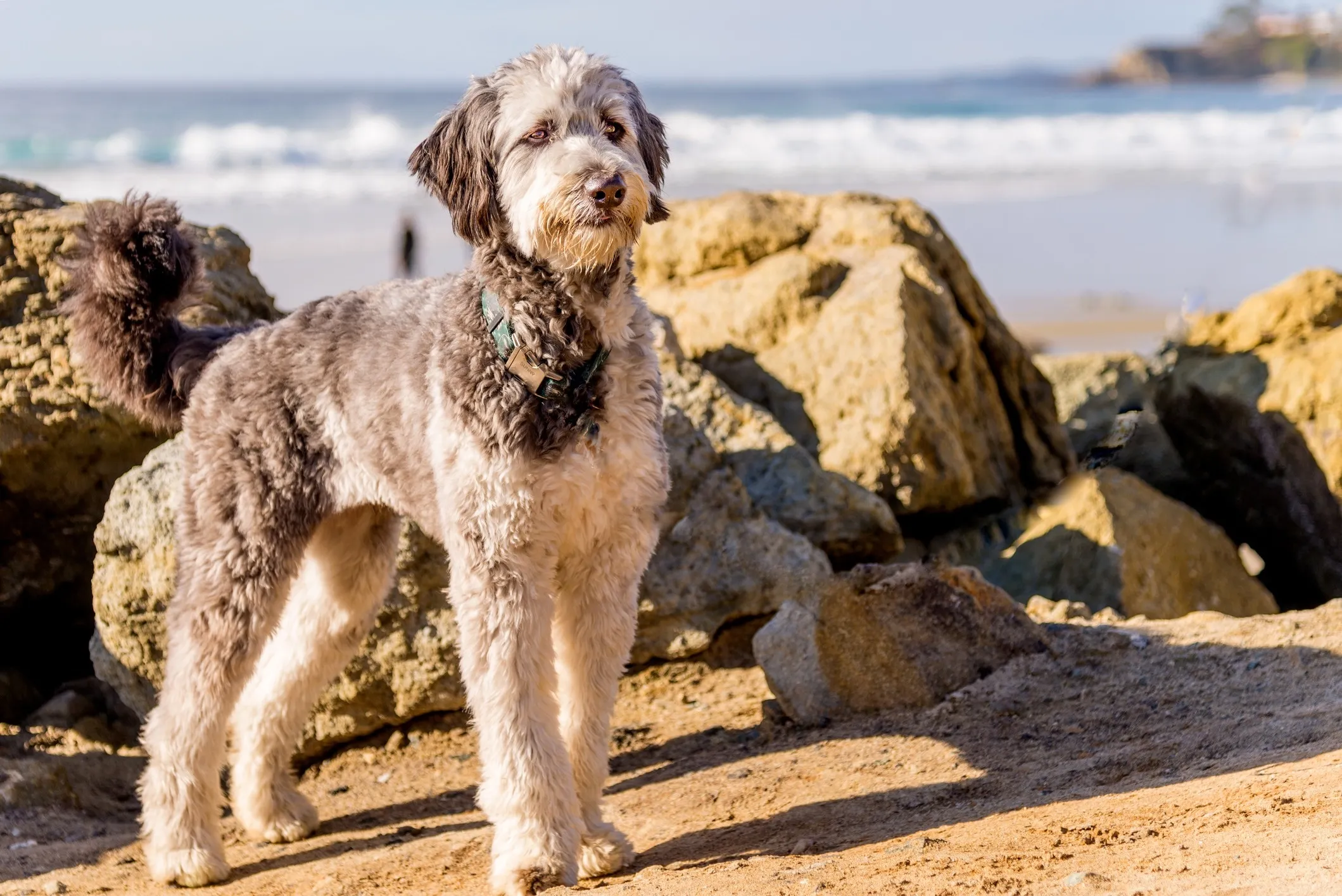 A striking Standard Aussiedoodle, a smart and energetic low-shedding crossbreed, standing elegantly on a sandy beach.An Aussiedoodle is a dynamic cross between an Australian Shepherd and a Standard or Miniature Poodle. This intelligent and incredibly energetic dog breed often inherits the low-shedding coat from its Poodle parent, making it a desirable choice for those looking to minimize shedding. Thanks to both parent breeds, Aussiedoodles are highly intelligent and require significant mental stimulation in addition to physical exercise. Without adequate engagement, they can become bored and potentially destructive. Providing plenty of enrichment toys and engaging in regular training sessions are essential for keeping an Aussiedoodle happy, well-behaved, and mentally stimulated. Their coats come in a variety of colors and patterns and need consistent grooming.
A striking Standard Aussiedoodle, a smart and energetic low-shedding crossbreed, standing elegantly on a sandy beach.An Aussiedoodle is a dynamic cross between an Australian Shepherd and a Standard or Miniature Poodle. This intelligent and incredibly energetic dog breed often inherits the low-shedding coat from its Poodle parent, making it a desirable choice for those looking to minimize shedding. Thanks to both parent breeds, Aussiedoodles are highly intelligent and require significant mental stimulation in addition to physical exercise. Without adequate engagement, they can become bored and potentially destructive. Providing plenty of enrichment toys and engaging in regular training sessions are essential for keeping an Aussiedoodle happy, well-behaved, and mentally stimulated. Their coats come in a variety of colors and patterns and need consistent grooming.
16. Bolognese
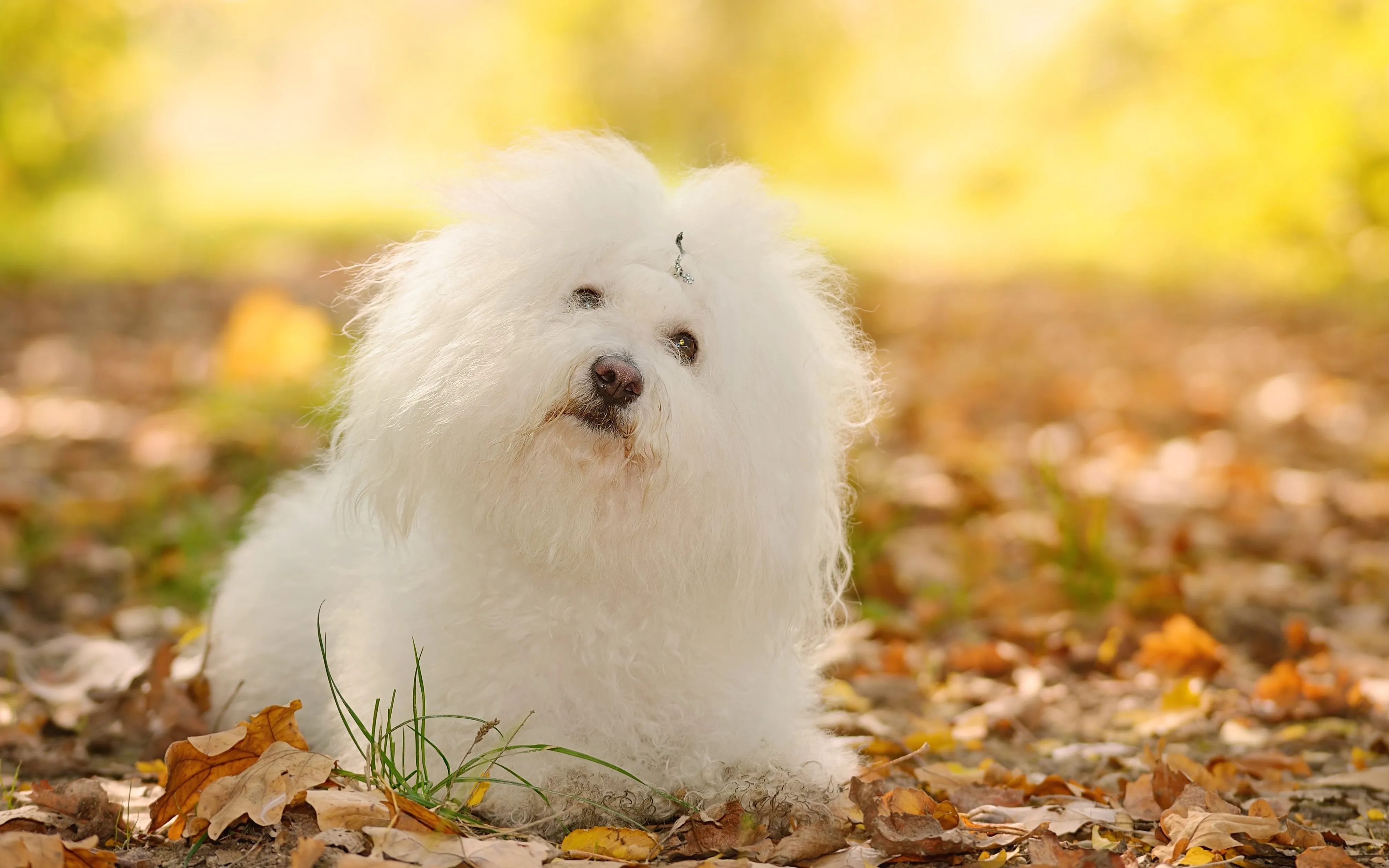 A fluffy white Bolognese dog, an affectionate and low-shedding companion, sitting attentively in an autumn forest setting.Bolognese dogs are charming, small Italian breeds known for their long, fluffy white coats that shed very little, making them an excellent choice for a dog breed that doesn’t shed much. Despite their characteristic “messy” appearance, their coats require extensive grooming to prevent matting and maintain their soft texture. These playful and easygoing pups are well-regarded for their ability to get along harmoniously with children and other pets. Their adaptable nature means Bolognese dogs can comfortably fit into various living situations, from bustling city apartments to quiet suburban homes, as long as they receive consistent companionship and affection.
A fluffy white Bolognese dog, an affectionate and low-shedding companion, sitting attentively in an autumn forest setting.Bolognese dogs are charming, small Italian breeds known for their long, fluffy white coats that shed very little, making them an excellent choice for a dog breed that doesn’t shed much. Despite their characteristic “messy” appearance, their coats require extensive grooming to prevent matting and maintain their soft texture. These playful and easygoing pups are well-regarded for their ability to get along harmoniously with children and other pets. Their adaptable nature means Bolognese dogs can comfortably fit into various living situations, from bustling city apartments to quiet suburban homes, as long as they receive consistent companionship and affection.
17. Maltese
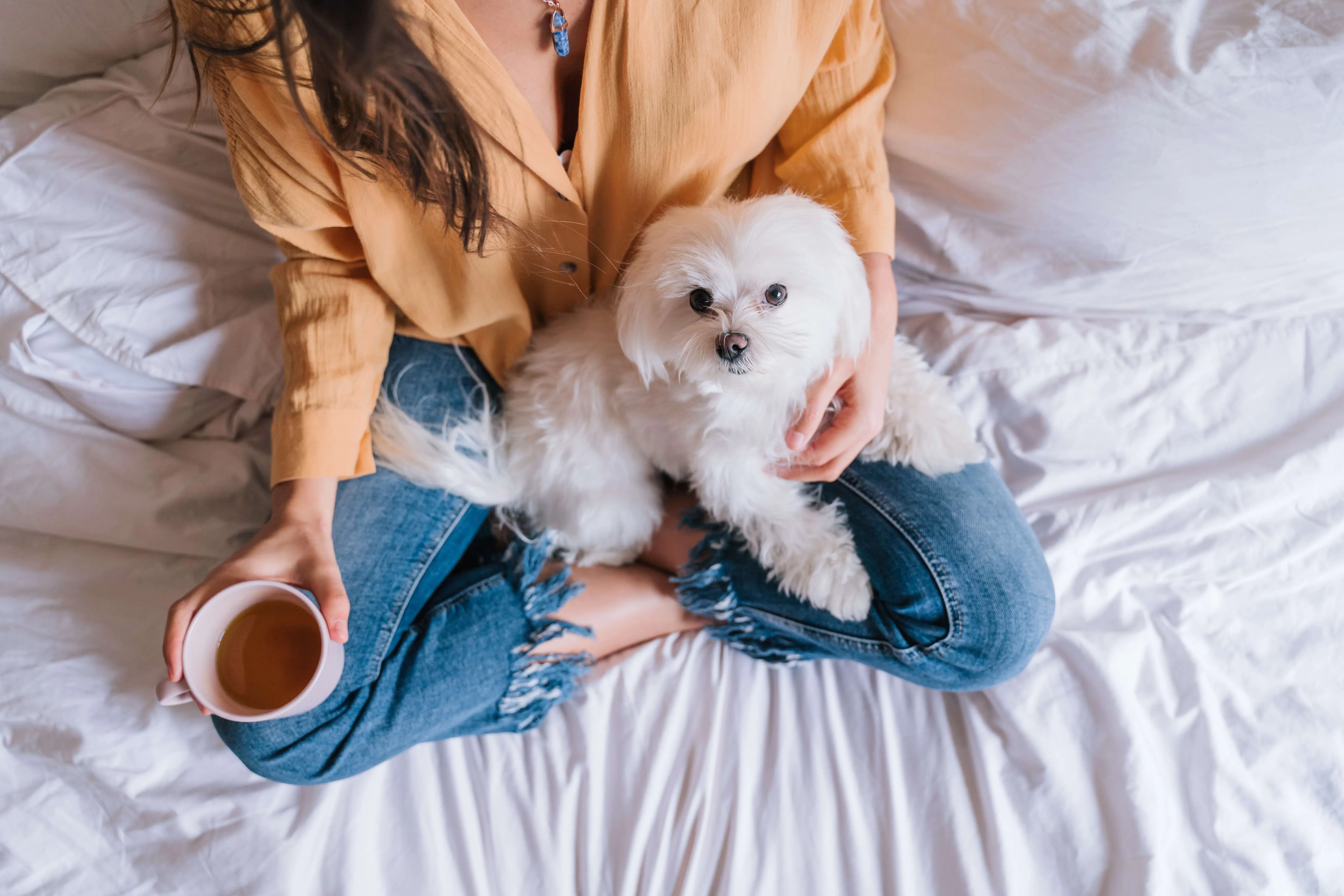 A woman lovingly holding a small white Maltese dog on a bed, showcasing its famous long, silken, low-shedding coat.The Maltese is a small, elegant dog breed celebrated for its luxurious, silky white coat that sheds minimally. This makes them a popular selection for pet parents who prioritize a low-shedding environment. Maltese dogs are affectionate, playful, and thrive on companionship, making devoted additions to any family. While their long coats are stunning, they demand diligent grooming to prevent tangles and mats. Many owners opt for a shorter “puppy cut” to simplify daily care, which can be easily maintained with regular brushing and occasional trims. Despite their delicate appearance, Maltese are robust and lively companions.
A woman lovingly holding a small white Maltese dog on a bed, showcasing its famous long, silken, low-shedding coat.The Maltese is a small, elegant dog breed celebrated for its luxurious, silky white coat that sheds minimally. This makes them a popular selection for pet parents who prioritize a low-shedding environment. Maltese dogs are affectionate, playful, and thrive on companionship, making devoted additions to any family. While their long coats are stunning, they demand diligent grooming to prevent tangles and mats. Many owners opt for a shorter “puppy cut” to simplify daily care, which can be easily maintained with regular brushing and occasional trims. Despite their delicate appearance, Maltese are robust and lively companions.
18. Soft Coated Wheaten Terrier
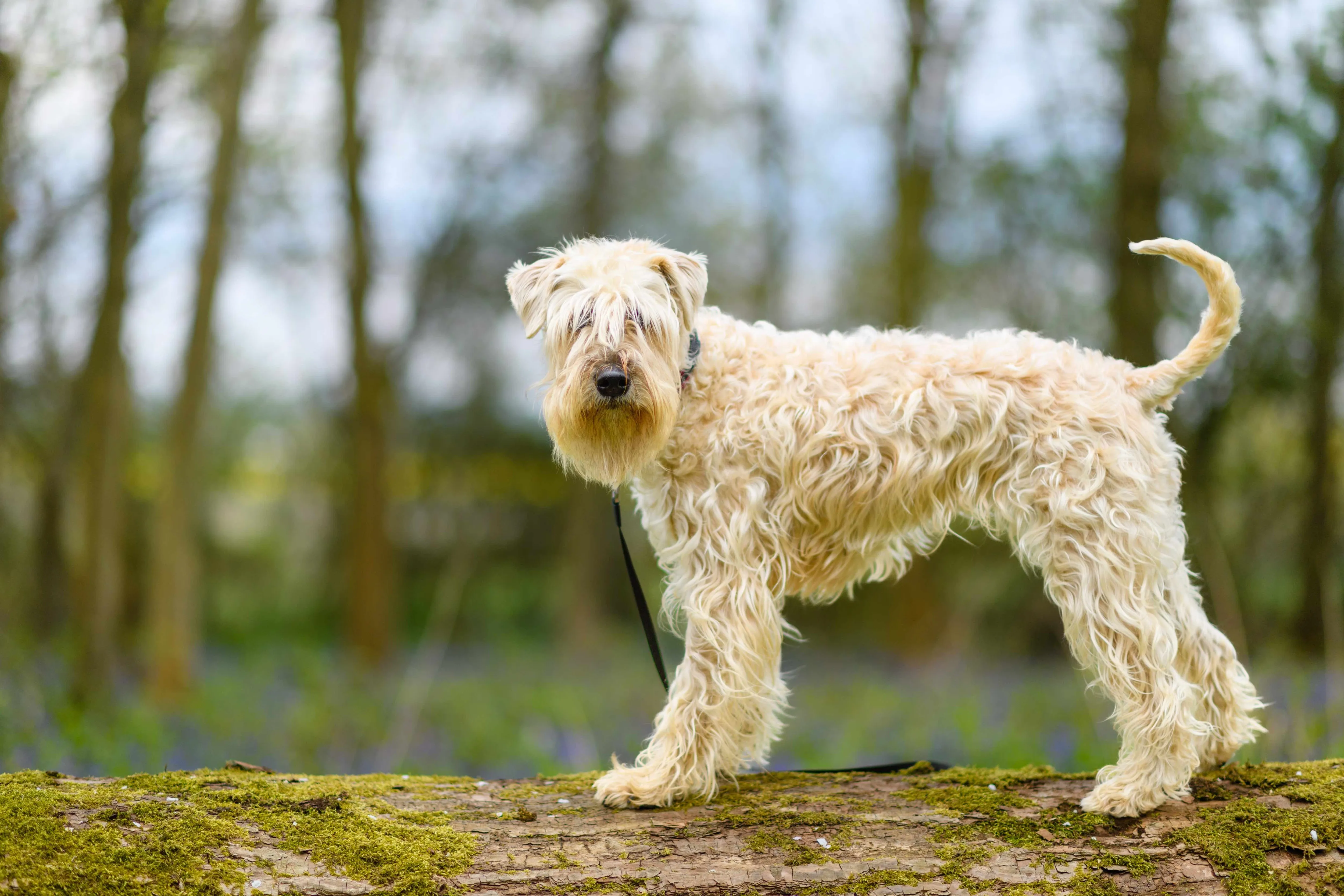 A handsome Soft Coated Wheaten Terrier, a lively and low-shedding Irish breed, poised on a fallen log in a natural setting.As its name implies, the Soft Coated Wheaten Terrier is a medium-sized Irish breed boasting an incredibly soft, silky coat that sheds remarkably little. This characteristic makes them a highly desirable dog breed that doesn’t shed much for those seeking a cleaner home. Wheatens are typical terriers in their boundless energy and require ample exercise and mental stimulation to channel their exuberance into positive behaviors. Their playful and often boisterous nature makes them engaging companions for active families. Despite their low shedding, their soft coat requires consistent daily brushing to prevent matting and keep it looking its best.
A handsome Soft Coated Wheaten Terrier, a lively and low-shedding Irish breed, poised on a fallen log in a natural setting.As its name implies, the Soft Coated Wheaten Terrier is a medium-sized Irish breed boasting an incredibly soft, silky coat that sheds remarkably little. This characteristic makes them a highly desirable dog breed that doesn’t shed much for those seeking a cleaner home. Wheatens are typical terriers in their boundless energy and require ample exercise and mental stimulation to channel their exuberance into positive behaviors. Their playful and often boisterous nature makes them engaging companions for active families. Despite their low shedding, their soft coat requires consistent daily brushing to prevent matting and keep it looking its best.
19. Coton de Tulear
 A beautiful white Coton de Tulear, a small and easygoing low-shedding breed, sitting in grass with its hair gently blowing in the wind.Originating from Madagascar, the Coton de Tulear is a small, charming breed known for its soft, cotton-like coat that sheds minimally. These easygoing pups are celebrated for their good nature and adaptability, making them excellent companions for families with children and other pets. Proper introductions are always key when bringing a Coton into a multi-pet household to ensure a harmonious environment. Their playful yet gentle disposition, combined with their low-shedding coat, positions them as a fantastic choice for many dog lovers. Regular grooming, including brushing several times a week, is necessary to keep their unique coat free of tangles and mats.
A beautiful white Coton de Tulear, a small and easygoing low-shedding breed, sitting in grass with its hair gently blowing in the wind.Originating from Madagascar, the Coton de Tulear is a small, charming breed known for its soft, cotton-like coat that sheds minimally. These easygoing pups are celebrated for their good nature and adaptability, making them excellent companions for families with children and other pets. Proper introductions are always key when bringing a Coton into a multi-pet household to ensure a harmonious environment. Their playful yet gentle disposition, combined with their low-shedding coat, positions them as a fantastic choice for many dog lovers. Regular grooming, including brushing several times a week, is necessary to keep their unique coat free of tangles and mats.
20. Schnoodle
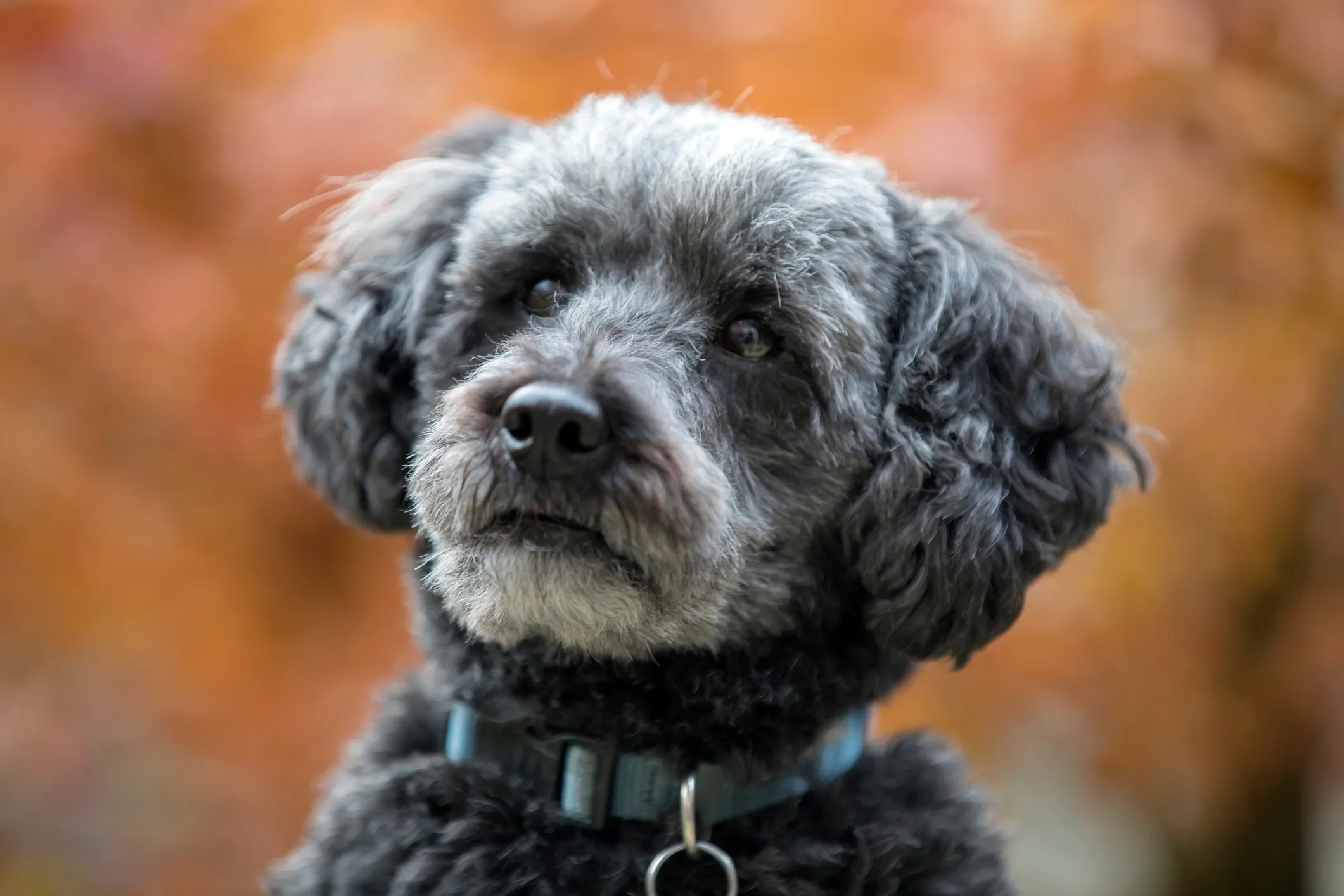 A close-up of a charming gray Schnoodle, a popular low-shedding hybrid combining two non-shedding breeds.The Schnoodle is a unique “doodle” breed, as it combines two distinct low-shedding dog breeds: the Schnauzer and the Poodle. This makes the Schnoodle an outstanding choice for anyone specifically seeking a dog breed that doesn’t shed much. Their coat texture can vary, appearing curly or wavy depending on the dominant genes inherited from their parents, but it is consistently low-shedding. Schnoodles are known for their intelligent, playful, and affectionate personalities. They make wonderful family pets and are often quite adaptable to different living situations, provided they receive regular exercise and mental engagement. Regular grooming is essential to keep their distinctive coat healthy and prevent matting.
A close-up of a charming gray Schnoodle, a popular low-shedding hybrid combining two non-shedding breeds.The Schnoodle is a unique “doodle” breed, as it combines two distinct low-shedding dog breeds: the Schnauzer and the Poodle. This makes the Schnoodle an outstanding choice for anyone specifically seeking a dog breed that doesn’t shed much. Their coat texture can vary, appearing curly or wavy depending on the dominant genes inherited from their parents, but it is consistently low-shedding. Schnoodles are known for their intelligent, playful, and affectionate personalities. They make wonderful family pets and are often quite adaptable to different living situations, provided they receive regular exercise and mental engagement. Regular grooming is essential to keep their distinctive coat healthy and prevent matting.
21. Bedlington Terrier
 A graceful white Bedlington Terrier, often called "a lamb in dog's clothing," running gracefully through fresh snow.Often affectionately called “a lamb in dog’s clothing,” the Bedlington Terrier is a small, curly-haired breed distinguished by its unique topknot hairdo and characteristic pom-pom ear tufts. Their woolly coat sheds very little, making them an excellent choice for those seeking a dog breed that doesn’t shed much. These dogs are deeply devoted to their human companions and thrive on being close to their people. Consequently, they can develop separation anxiety if left alone for extended periods. Monitoring their activity with a dog camera can help identify and address early signs of anxiety. Regular grooming, including clipping and shaping, is necessary to maintain their iconic appearance.
A graceful white Bedlington Terrier, often called "a lamb in dog's clothing," running gracefully through fresh snow.Often affectionately called “a lamb in dog’s clothing,” the Bedlington Terrier is a small, curly-haired breed distinguished by its unique topknot hairdo and characteristic pom-pom ear tufts. Their woolly coat sheds very little, making them an excellent choice for those seeking a dog breed that doesn’t shed much. These dogs are deeply devoted to their human companions and thrive on being close to their people. Consequently, they can develop separation anxiety if left alone for extended periods. Monitoring their activity with a dog camera can help identify and address early signs of anxiety. Regular grooming, including clipping and shaping, is necessary to maintain their iconic appearance.
22. Xoloitzcuintli
 A sleek black Mexican Hairless Dog (Xoloitzcuintli), an ancient and low-shedding breed, standing alertly in lush green grass.The Xoloitzcuintli, also known as the Mexican Hairless Dog, is one of the world’s oldest and rarest dog breeds, and it’s celebrated for being a dog breed that doesn’t shed much. This breed comes in three sizes—toy, miniature, and standard—and can be found in both hairless and coated varieties. The hairless Xolo is nearly entirely devoid of hair, while the coated Xolo possesses a very short, sleek coat. Both variations are considered low-shedding, with the hairless variety being particularly appealing to allergy sufferers. Xolos are known for their calm, vigilant, and affectionate nature, forming deep bonds with their families. The hairless variety requires specific skin care to protect it from the elements.
A sleek black Mexican Hairless Dog (Xoloitzcuintli), an ancient and low-shedding breed, standing alertly in lush green grass.The Xoloitzcuintli, also known as the Mexican Hairless Dog, is one of the world’s oldest and rarest dog breeds, and it’s celebrated for being a dog breed that doesn’t shed much. This breed comes in three sizes—toy, miniature, and standard—and can be found in both hairless and coated varieties. The hairless Xolo is nearly entirely devoid of hair, while the coated Xolo possesses a very short, sleek coat. Both variations are considered low-shedding, with the hairless variety being particularly appealing to allergy sufferers. Xolos are known for their calm, vigilant, and affectionate nature, forming deep bonds with their families. The hairless variety requires specific skin care to protect it from the elements.
23. Whoodle
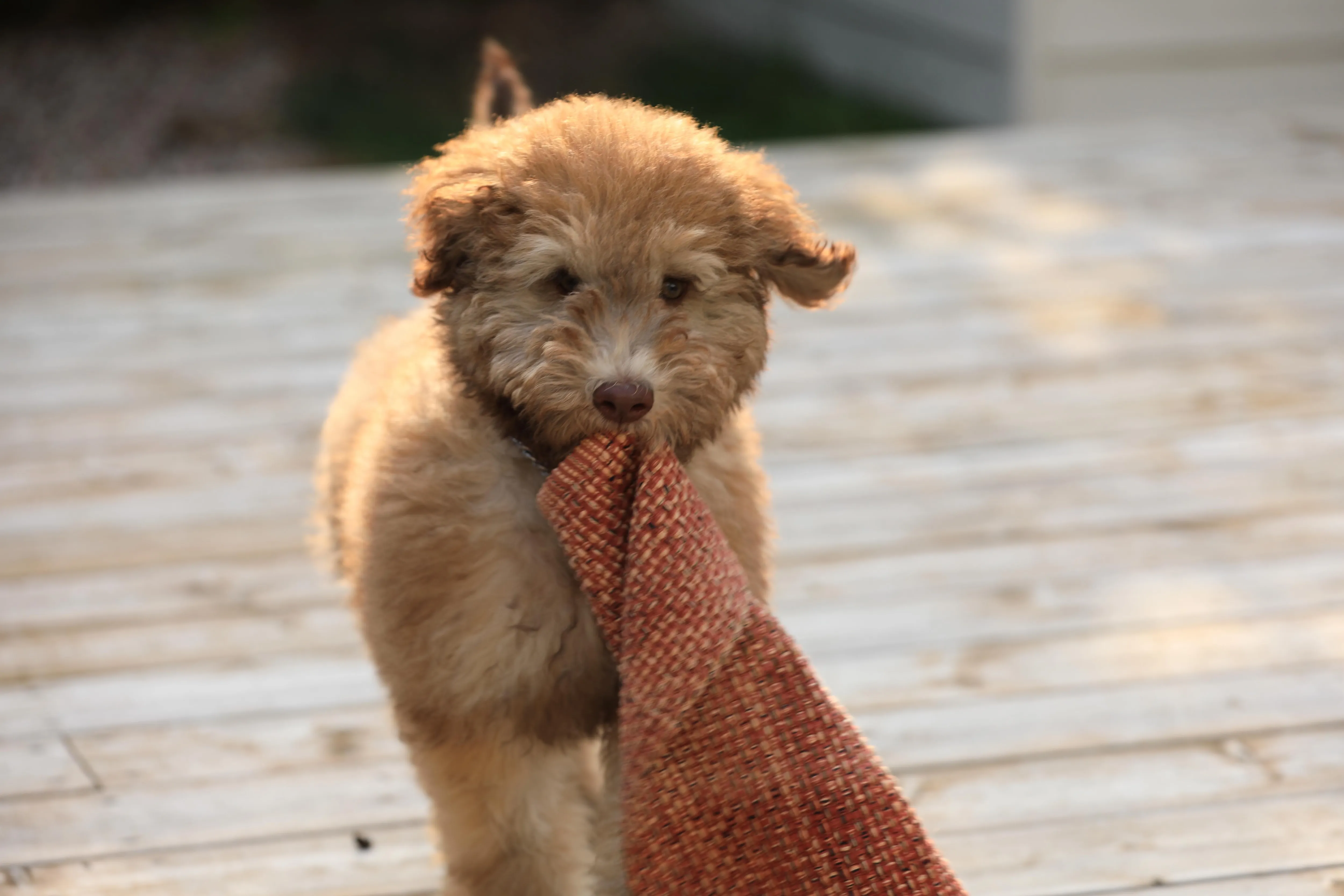 An adorable tan Whoodle puppy playfully dragging a washcloth, showcasing its soft, low-shedding coat and lively spirit.A Whoodle is a delightful crossbreed resulting from the combination of a Soft-Coated Wheaten Terrier and a Poodle. This friendly dog inherits the low-shedding qualities from both parent breeds, making it an excellent option for those seeking a dog breed that doesn’t shed much at all. Whoodles are known for their intelligence and affectionate nature, making them highly trainable and loving family members. They possess a playful spirit and thrive on interaction with their owners. Their soft, wavy to curly coats require regular brushing and professional grooming to prevent matting and keep them looking tidy.
An adorable tan Whoodle puppy playfully dragging a washcloth, showcasing its soft, low-shedding coat and lively spirit.A Whoodle is a delightful crossbreed resulting from the combination of a Soft-Coated Wheaten Terrier and a Poodle. This friendly dog inherits the low-shedding qualities from both parent breeds, making it an excellent option for those seeking a dog breed that doesn’t shed much at all. Whoodles are known for their intelligence and affectionate nature, making them highly trainable and loving family members. They possess a playful spirit and thrive on interaction with their owners. Their soft, wavy to curly coats require regular brushing and professional grooming to prevent matting and keep them looking tidy.
24. Bernedoodle
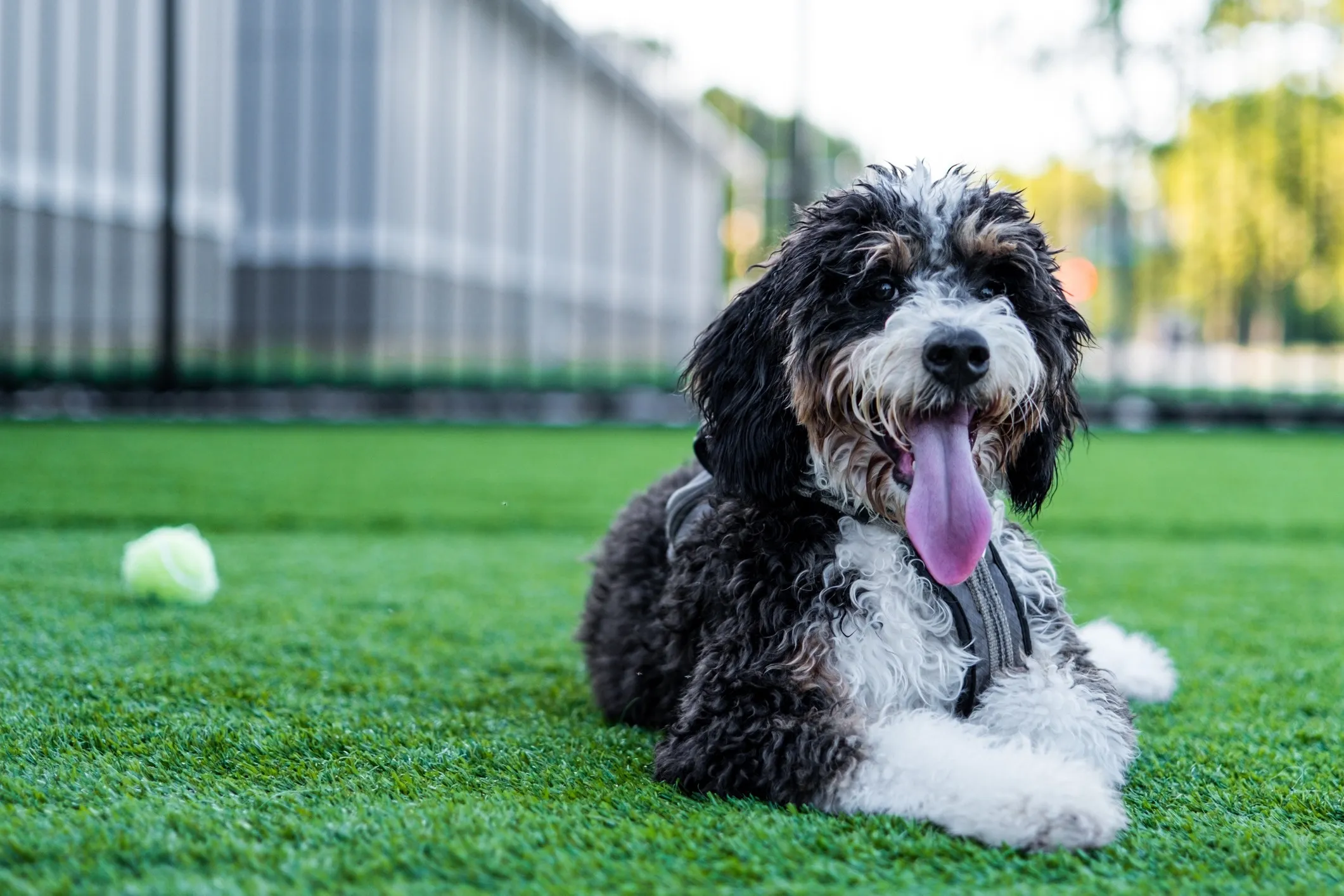 A large, friendly Bernedoodle, a popular low-shedding family dog, lying contentedly in green grass with its tongue out.Bernedoodles are a charming crossbreed between the majestic Bernese Mountain Dog and a Poodle. These large, affectionate dogs inherit the Poodle’s low-shedding coat, making them a popular choice for families looking for a sizable dog breed that doesn’t shed much. Known for their friendly, gentle demeanor and affectionate nature, Bernedoodles make wonderful family companions, especially in households with children and other pets. They are intelligent and generally easy to train. However, due to their size and energetic lineage, they require plenty of exercise to stay active and well-behaved, thriving on outdoor adventures and playtime. Their coats need regular grooming to stay healthy and mat-free.
A large, friendly Bernedoodle, a popular low-shedding family dog, lying contentedly in green grass with its tongue out.Bernedoodles are a charming crossbreed between the majestic Bernese Mountain Dog and a Poodle. These large, affectionate dogs inherit the Poodle’s low-shedding coat, making them a popular choice for families looking for a sizable dog breed that doesn’t shed much. Known for their friendly, gentle demeanor and affectionate nature, Bernedoodles make wonderful family companions, especially in households with children and other pets. They are intelligent and generally easy to train. However, due to their size and energetic lineage, they require plenty of exercise to stay active and well-behaved, thriving on outdoor adventures and playtime. Their coats need regular grooming to stay healthy and mat-free.
25. Shorkie
 A small, spirited tan and black Shorkie, a low-shedding mixed breed, sitting alertly on a hiking trail, ready for adventure.The Shorkie is a lively mixed breed combining two popular low-shedding dogs: the Shih Tzu and the Yorkshire Terrier. This delightful cross results in a small, playful, and friendly companion that benefits from the minimal shedding characteristics of both parent breeds. Shorkies embody the best traits of both breeds—they are affectionate, spirited, and highly adaptable to various living situations. However, like most dogs on this list, they require a dedicated and regular grooming routine to maintain their fine, flowing coats and prevent tangles. Their small size makes them ideal for apartment living, provided they receive adequate exercise and attention.
A small, spirited tan and black Shorkie, a low-shedding mixed breed, sitting alertly on a hiking trail, ready for adventure.The Shorkie is a lively mixed breed combining two popular low-shedding dogs: the Shih Tzu and the Yorkshire Terrier. This delightful cross results in a small, playful, and friendly companion that benefits from the minimal shedding characteristics of both parent breeds. Shorkies embody the best traits of both breeds—they are affectionate, spirited, and highly adaptable to various living situations. However, like most dogs on this list, they require a dedicated and regular grooming routine to maintain their fine, flowing coats and prevent tangles. Their small size makes them ideal for apartment living, provided they receive adequate exercise and attention.
26. Afghan Hound
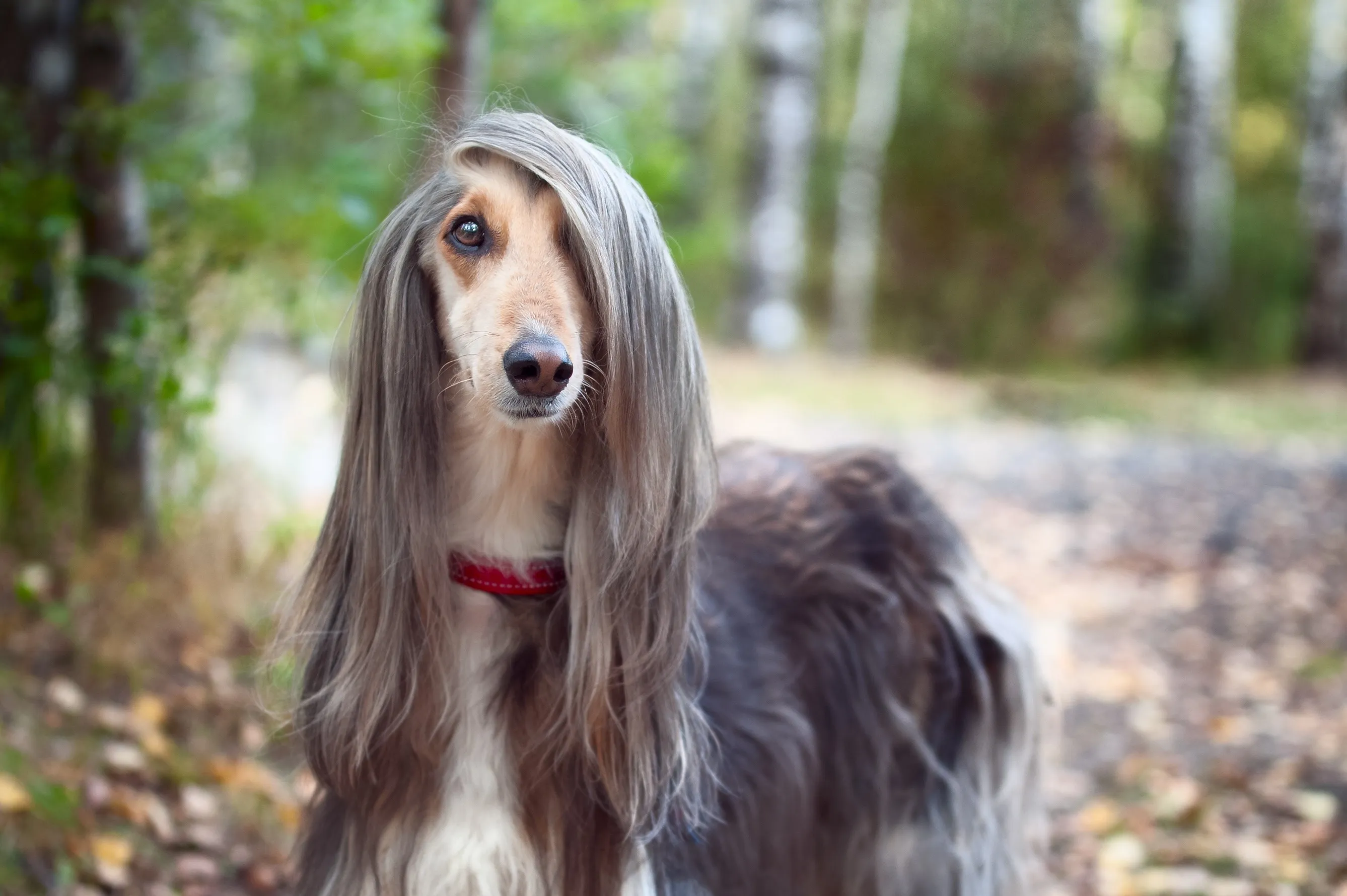 A regal gray and tan Afghan Hound, known for its long, flowing, low-shedding coat, gazing directly at the camera with dignity.Afghan Hounds are instantly recognizable by their aristocratic appearance, featuring a long, flowing coat and slender, elegant build. Despite their abundant hair, this breed is considered a low-shedder, with its fine, human-like hair shedding less frequently than many other breeds. These majestic pups are built for speed and are among the fastest dog breeds in the world, requiring regular opportunities to run and expend their energy. While loving and devoted to their families, Afghan Hounds can be aloof and independent with strangers, making early and consistent socialization vital for fostering a well-adjusted temperament. Their magnificent coats demand extensive daily grooming to prevent tangles and maintain their signature flowing look.
A regal gray and tan Afghan Hound, known for its long, flowing, low-shedding coat, gazing directly at the camera with dignity.Afghan Hounds are instantly recognizable by their aristocratic appearance, featuring a long, flowing coat and slender, elegant build. Despite their abundant hair, this breed is considered a low-shedder, with its fine, human-like hair shedding less frequently than many other breeds. These majestic pups are built for speed and are among the fastest dog breeds in the world, requiring regular opportunities to run and expend their energy. While loving and devoted to their families, Afghan Hounds can be aloof and independent with strangers, making early and consistent socialization vital for fostering a well-adjusted temperament. Their magnificent coats demand extensive daily grooming to prevent tangles and maintain their signature flowing look.
27. Barbet
 A close-up of a curly red Barbet dog's face, highlighting its characteristic shaggy, woolly, and low-shedding coat.The Barbet, pronounced “bar-bay,” is a cheerful and robust dog with a distinctive shaggy, woolly coat that sheds very little. Its name comes from the French word barbe, meaning beard, a nod to the breed’s characteristically hairy chin. This medium-to-large low-shedding dog thrives in water, thanks to its protective curly coat, and loves to swim. Regular exercise and opportunities for water play are essential for a happy and healthy Barbet. To keep their unique coat in good condition, especially after water activities, it’s crucial to brush them with a slicker or pin brush two to three times a week to prevent matting and ensure cleanliness.
A close-up of a curly red Barbet dog's face, highlighting its characteristic shaggy, woolly, and low-shedding coat.The Barbet, pronounced “bar-bay,” is a cheerful and robust dog with a distinctive shaggy, woolly coat that sheds very little. Its name comes from the French word barbe, meaning beard, a nod to the breed’s characteristically hairy chin. This medium-to-large low-shedding dog thrives in water, thanks to its protective curly coat, and loves to swim. Regular exercise and opportunities for water play are essential for a happy and healthy Barbet. To keep their unique coat in good condition, especially after water activities, it’s crucial to brush them with a slicker or pin brush two to three times a week to prevent matting and ensure cleanliness.
28. Shih-Poo
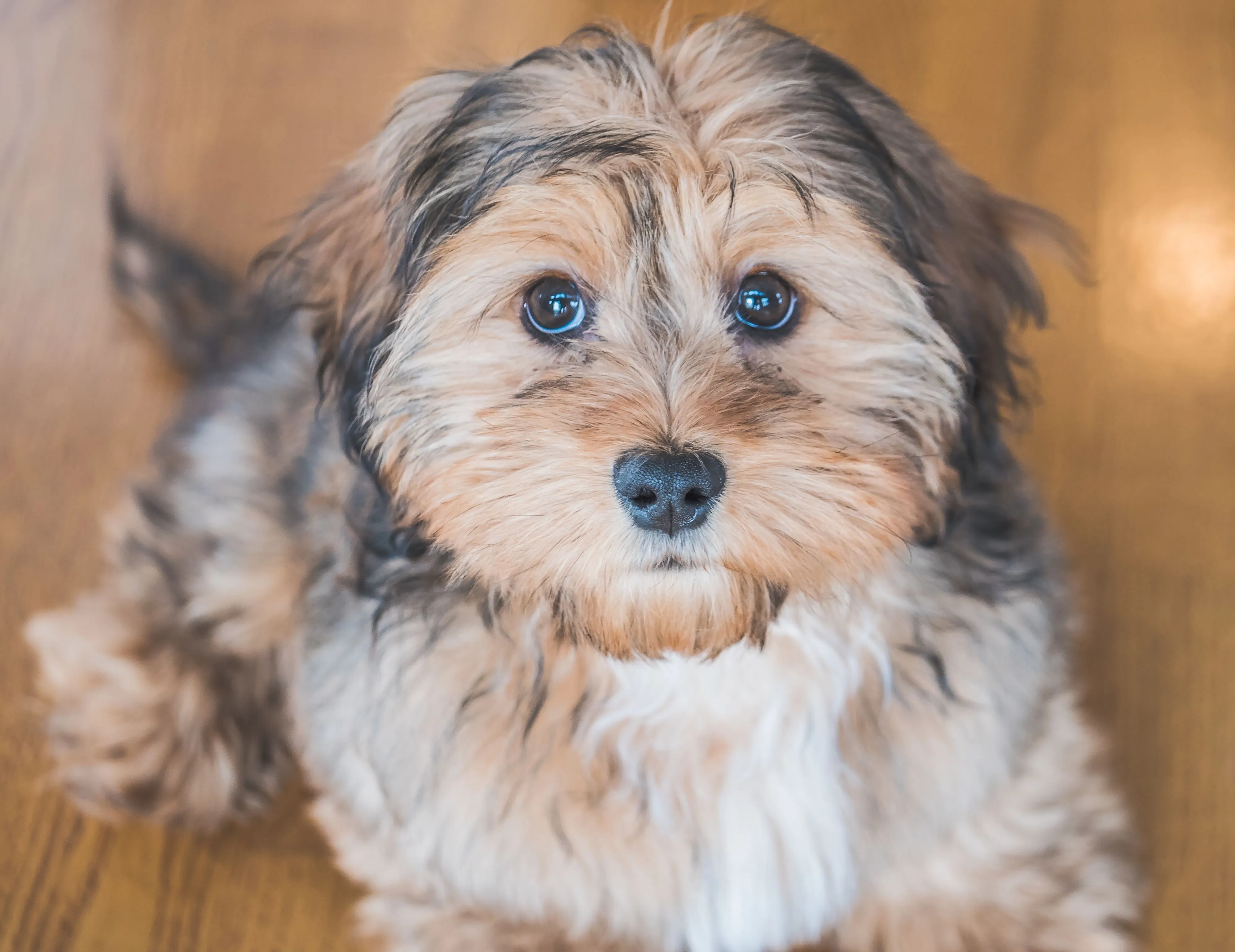 A charming tan and black Shih-Poo dog, a small and affectionate low-shedding mixed breed, featured in a close-up shot.The Shih-Poo is a delightful mixed breed resulting from the cross between a Shih Tzu and a Poodle, most commonly the Toy Poodle. This small, charming pup inherits the low-shedding characteristics of both parent breeds, making it an excellent choice for those seeking a dog breed that doesn’t shed much. Shih-Poos are highly adaptable and can thrive in almost any living situation, from apartments to larger homes, as long as they receive consistent attention, approximately 30 minutes of daily exercise, and a good brushing session each day. They are known for their affectionate, playful, and sometimes spirited personalities, making them loving companions.
A charming tan and black Shih-Poo dog, a small and affectionate low-shedding mixed breed, featured in a close-up shot.The Shih-Poo is a delightful mixed breed resulting from the cross between a Shih Tzu and a Poodle, most commonly the Toy Poodle. This small, charming pup inherits the low-shedding characteristics of both parent breeds, making it an excellent choice for those seeking a dog breed that doesn’t shed much. Shih-Poos are highly adaptable and can thrive in almost any living situation, from apartments to larger homes, as long as they receive consistent attention, approximately 30 minutes of daily exercise, and a good brushing session each day. They are known for their affectionate, playful, and sometimes spirited personalities, making them loving companions.
29. Peruvian Inca Orchid
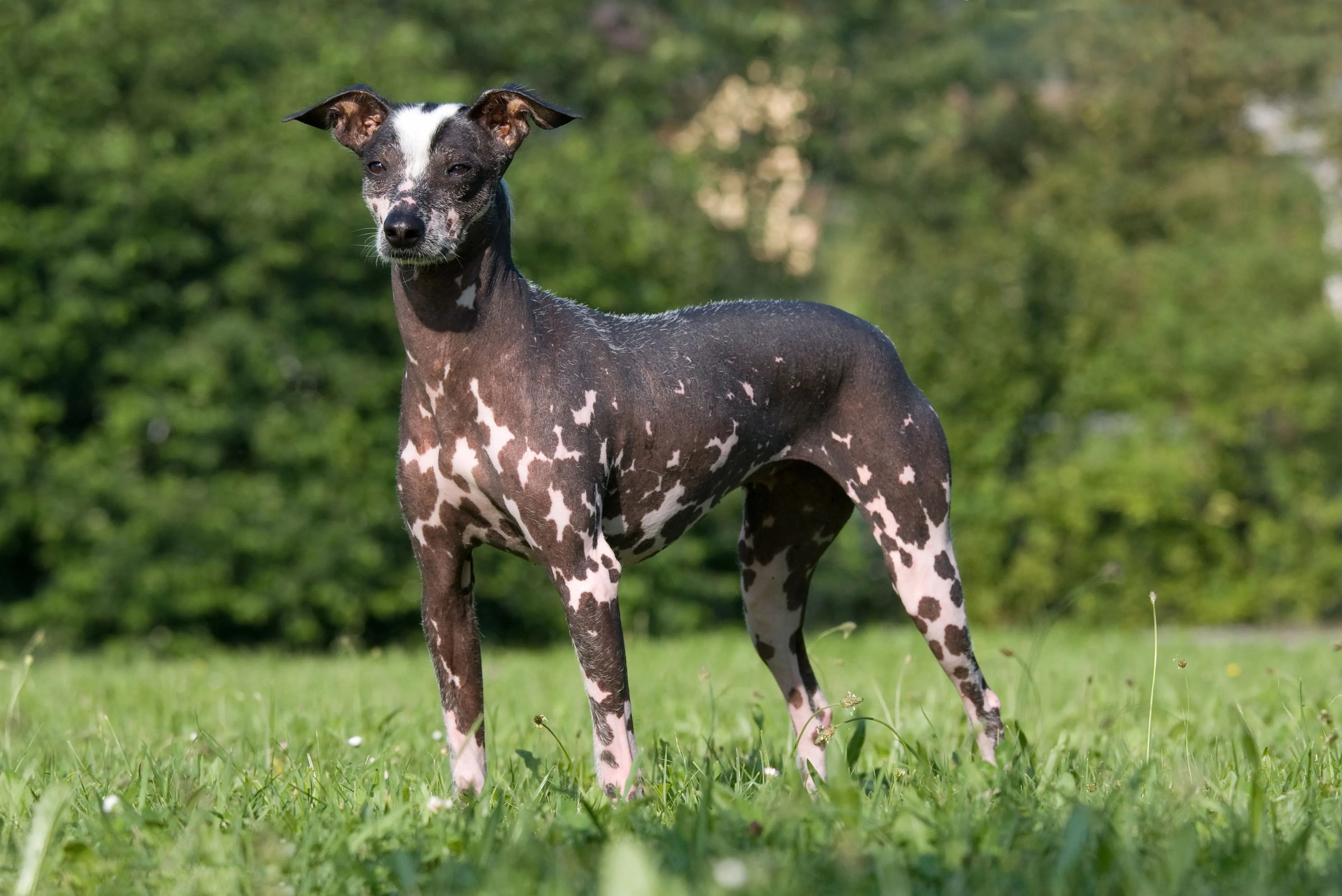 A striking Peruvian Inca Orchid dog, an ancient and rare hairless breed, showcasing its unique and naturally low-shedding body.The Peruvian Inca Orchid is a rare and ancient dog breed, native to Peru, and proudly holds the title of the country’s national dog. These unique dogs are naturally low-shedding thanks to their nearly hairless bodies, making them a fantastic option for individuals sensitive to dander. They come in three sizes—small, medium, and large—and exhibit a sleek, elegant physique. While predominantly hairless, some individuals may have a fine, short coat. Peruvian Inca Orchids are known for their calm, affectionate nature with their families, yet they can be quite reserved around strangers. Their hairless skin requires protection from extreme weather, including sunscreen in summer and warm clothing in winter.
A striking Peruvian Inca Orchid dog, an ancient and rare hairless breed, showcasing its unique and naturally low-shedding body.The Peruvian Inca Orchid is a rare and ancient dog breed, native to Peru, and proudly holds the title of the country’s national dog. These unique dogs are naturally low-shedding thanks to their nearly hairless bodies, making them a fantastic option for individuals sensitive to dander. They come in three sizes—small, medium, and large—and exhibit a sleek, elegant physique. While predominantly hairless, some individuals may have a fine, short coat. Peruvian Inca Orchids are known for their calm, affectionate nature with their families, yet they can be quite reserved around strangers. Their hairless skin requires protection from extreme weather, including sunscreen in summer and warm clothing in winter.
30. Malshi
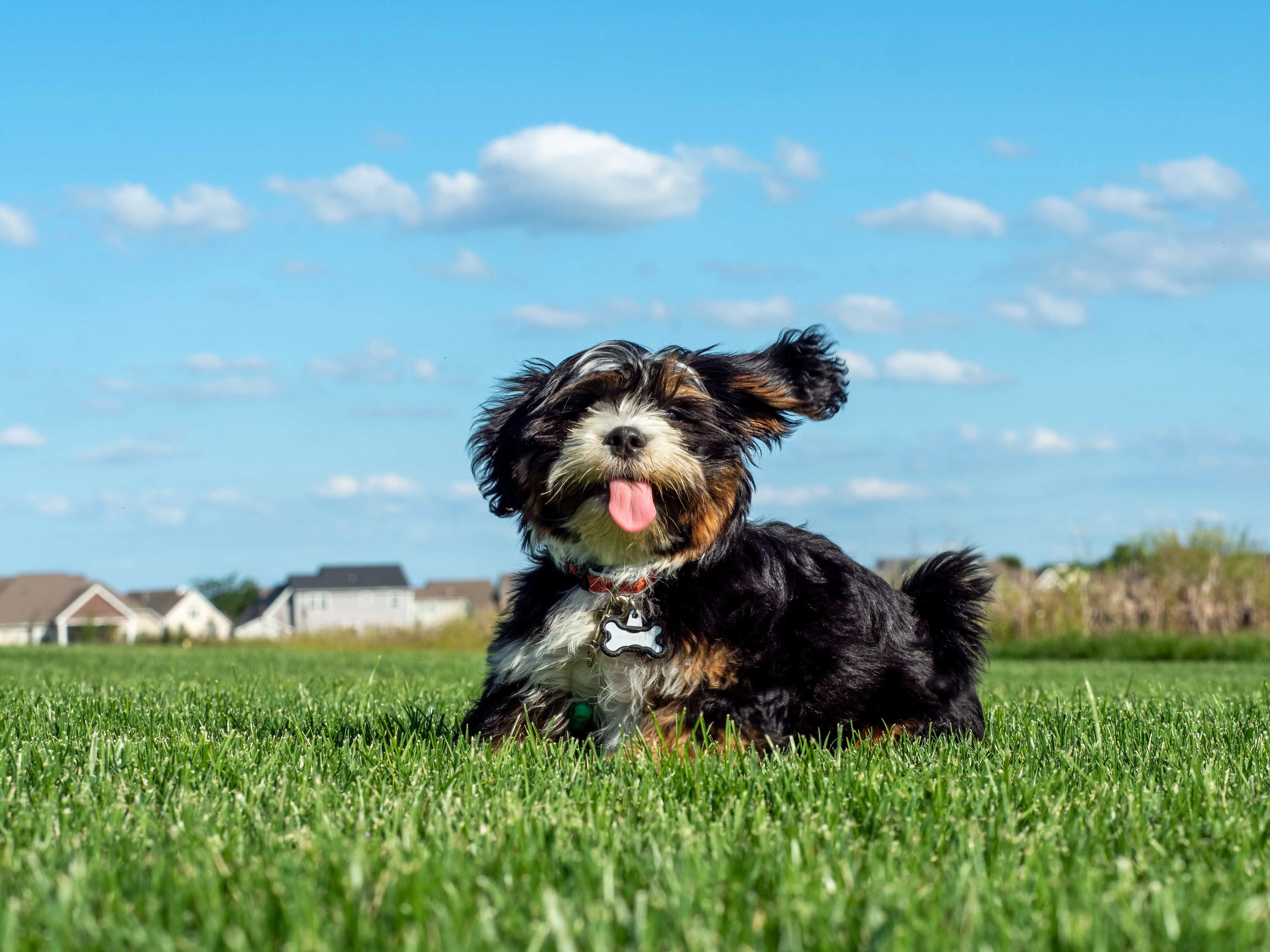 A playful tricolor Malshi dog, a small and happy low-shedding companion, enjoying time in vibrant green grass.The Malshi is a happy and small mixed breed, a delightful cross between the Maltese and Shih Tzu. This combination results in a charming companion that boasts the low-shedding qualities of both parent breeds. Malshis thrive on close companionship and are happiest when their favorite humans are near, forming strong bonds with their families. They are known for their affectionate, playful, and sometimes mischievous personalities. Like many dogs on this list, their lovely coats, while low-shedding, require dedication to a regular grooming routine to keep them free of tangles and looking their best. Their small size makes them ideal for apartment living and for those seeking a devoted lap dog.
A playful tricolor Malshi dog, a small and happy low-shedding companion, enjoying time in vibrant green grass.The Malshi is a happy and small mixed breed, a delightful cross between the Maltese and Shih Tzu. This combination results in a charming companion that boasts the low-shedding qualities of both parent breeds. Malshis thrive on close companionship and are happiest when their favorite humans are near, forming strong bonds with their families. They are known for their affectionate, playful, and sometimes mischievous personalities. Like many dogs on this list, their lovely coats, while low-shedding, require dedication to a regular grooming routine to keep them free of tangles and looking their best. Their small size makes them ideal for apartment living and for those seeking a devoted lap dog.
Essential Tips for Living With a Low-Shedding Dog
While choosing a dog breed that doesn’t shed much significantly reduces pet hair and dander, maintaining a healthy and comfortable environment for both you and your furry friend requires a proactive approach. Here are crucial tips for pet parents adopting or purchasing a low-shedding dog:
Keep Up With Grooming
Even dogs that shed minimally require consistent grooming and maintenance to ensure their coats remain clean, healthy, and mat-free. Regular grooming is paramount to managing loose hair that gets trapped in their coats and reducing dander in your home.
- Brushing: Most low-shedding breeds, especially those with curly or long coats, need daily or at least several times a week brushing. This helps remove loose hair and prevents matting, which can be uncomfortable and lead to skin issues. Invest in the right type of brush for your dog’s specific coat, such as a slicker brush or a pin brush.
- Bathing: While not all low-shedding dogs need frequent baths, aiming for a bath every four to six weeks is a good general guideline. Some breeds with oily coats or specific skin conditions might benefit from more frequent bathing. Using a gentle, dog-specific shampoo and conditioner can help maintain skin and coat health. For individuals with allergies, specific dander-reducing shampoos can be very helpful.
- Professional Grooming: Many low-shedding breeds, particularly Poodles and Poodle mixes, require regular professional trimming or hand-stripping to maintain their coat’s length and style. Budgeting for these visits or learning to groom your pup at home is an important consideration. Neglecting professional grooming can lead to severe matting, requiring drastic measures like shaving.
Maintain a Clean House
Even with a low-shedding dog, allergens and dander can accumulate in your home. Minimizing these triggers requires diligent household cleaning practices.
- Vacuum Regularly: Use a vacuum cleaner equipped with a HEPA filter to effectively capture pet dander and other allergens from carpets, rugs, and upholstery. Regular vacuuming, especially in areas your dog frequents, is key.
- Dust Frequently: Dust surfaces with a damp cloth to trap allergens rather than simply moving them around. Pay attention to elevated surfaces and crevices where dander can settle.
- Wash Bedding: Regularly wash your dog’s bedding, as well as your own bedding, in hot water to remove dander and allergens. Consider allergen-proof covers for pillows and mattresses.
- Air Filtration: Utilize air purifiers with HEPA filters in main living areas and bedrooms to help remove airborne allergens. Ensuring good ventilation by opening windows when weather permits can also help.
Talk to Your Doctor
Managing allergies is a personal journey, and while a low-shedding dog can significantly improve quality of life for individuals with allergies, it’s crucial to consult with your healthcare provider or an allergist.
- Professional Advice: Your doctor can offer personalized advice and treatment options for managing pet allergies. This might include over-the-counter or prescription medications, nasal sprays, or allergy shots (immunotherapy) that can significantly reduce your sensitivity.
- Avoid Contact: Even with a low-shedding dog, it’s wise to minimize direct contact with your dog’s saliva and urine, as these can also contain potent allergens. Simple practices like washing hands after playing with your dog and avoiding face licking can make a difference.
- Designated “Allergen-Free” Zones: Consider creating specific areas in your home, such as your bedroom, where your dog is not allowed. This can provide a sanctuary with reduced allergen exposure, allowing your body to recover overnight.
Bringing home a dog breed that doesn’t shed much can indeed be a wonderful way to experience the profound joy and companionship of pet parenthood, even for those with mild allergies or a preference for a cleaner home. By combining the right breed choice with consistent grooming and diligent home maintenance, you can create a harmonious environment for both you and your beloved low-shedding companion.
